
Sales trend analysis (STA) is the cornerstone of sustainable business growth, so knowing its ins and outs is essential. As a rookie in the field, you must still be in the stage of learning the ropes, so we're here to help you.
This guide will equip you with essential skills to decipher market fluctuations, customer behaviors, and emerging patterns. We delve deep into sales data analysis techniques, empowering you to make informed decisions, optimize inventory, enhance customer experiences, and boost profitability.
From leveraging advanced analytics tools to practical tips on interpreting consumer preferences, this comprehensive resource is your road map to navigating the ever-changing ecommerce terrain. So, let's begin!
Making informed decisions and developing strategies are some benefits of STA. By understanding the underlying trends, companies can anticipate market demand, identify high-performing products or services, and focus on areas that require improvement.
A comprehensive sales analysis must consider these key components and factors.
((Current Period Value - Base Period Value) / Base Period Value) * 100
Getting the answer involves gathering historical sales data and ensuring all the gathered details are accurate and updated. The answers will provide patterns or deviations over a specified period. By analyzing these trends, you’ll know the behavior of your target market and base your decisions on data instead of instinct.
| Key Metrics | |
| Revenue and Sales Growth Trends | Check sales revenue over a specific time Project business financial health Provide efficiency insights of sales strategies and marketing efforts |
| Customer Acquisition and Retention Trends | Show new customers acquisition rate Check efficiency of customer retention game plans Determine customer acquisition and retention processes pain points |
| Product or Service Performance Trends | Evaluate products and services performance based on sales and customer feedback Determine the success and popularity of specific offerings Help identify potential opportunities for product or service improvements |
| Market and Industry Trends | Assess the overall state and direction of the market and industry Identify emerging trends and changes that can impact sales and revenue Help you formulate the latest strategies at par with competitors |
| Competitor Sales Data Analysis and Benchmarking | Analyze the performance of competitors in the market Identify strengths and weaknesses of competitors' sales strategies Benchmark against industry peers to measure performance and identify areas for improvement. |
Gathering Data
If you want to make data gathering easier, keep an eye on the details and establish a process too. How so? You can check out the details below.
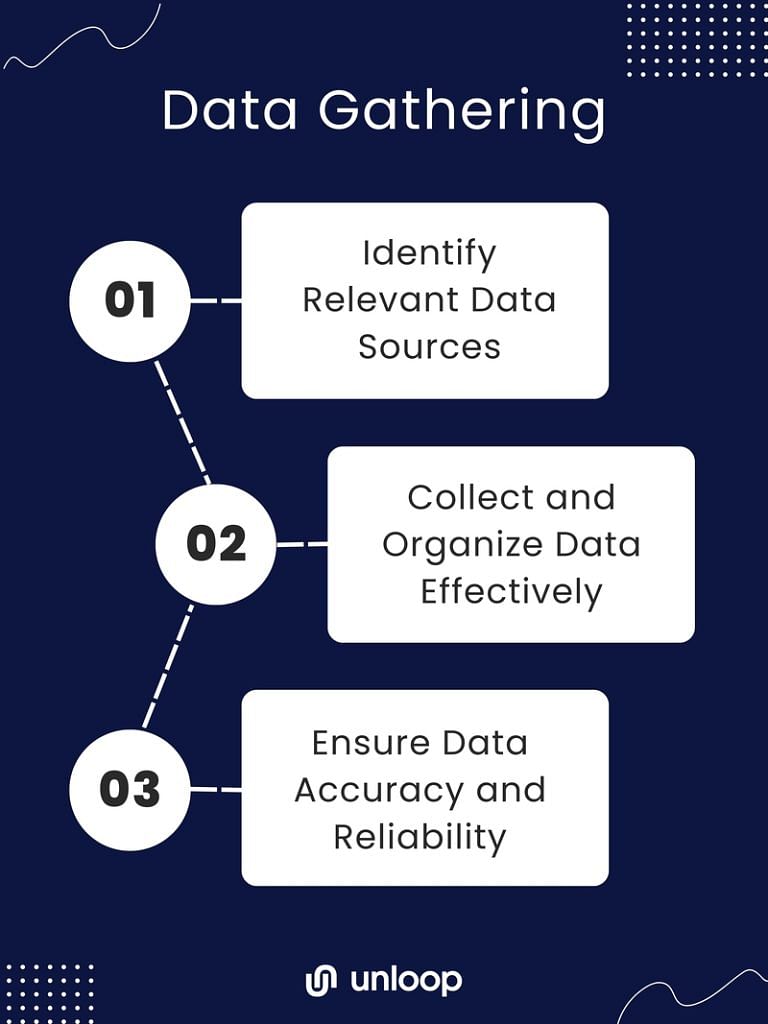
Identifying the sources that provide accurate and reliable data for analysis is crucial. This may include internal sources such as Customer Relationship Management (CRM) systems, different kinds of reports, and customer data. External sources like market research reports, industry publications, and competitor analysis can give you better financial judgment when monitored.
Once the relevant data sources are identified, collect and organize them. Capture data consistently over time using standardized formats, and maintain proper documentation. Because automated tools and data management systems are champions in streamlining collection, organization of information from various channels are done swiftly.
Validate the collected data to eliminate duplicates or errors and address inconsistencies. Regular audits and cross-checking with multiple sources help ensure reliable figures for analysis.
After gathering data and keeping them organized, you must know how to make sense of them, and below are just some ways to do so.
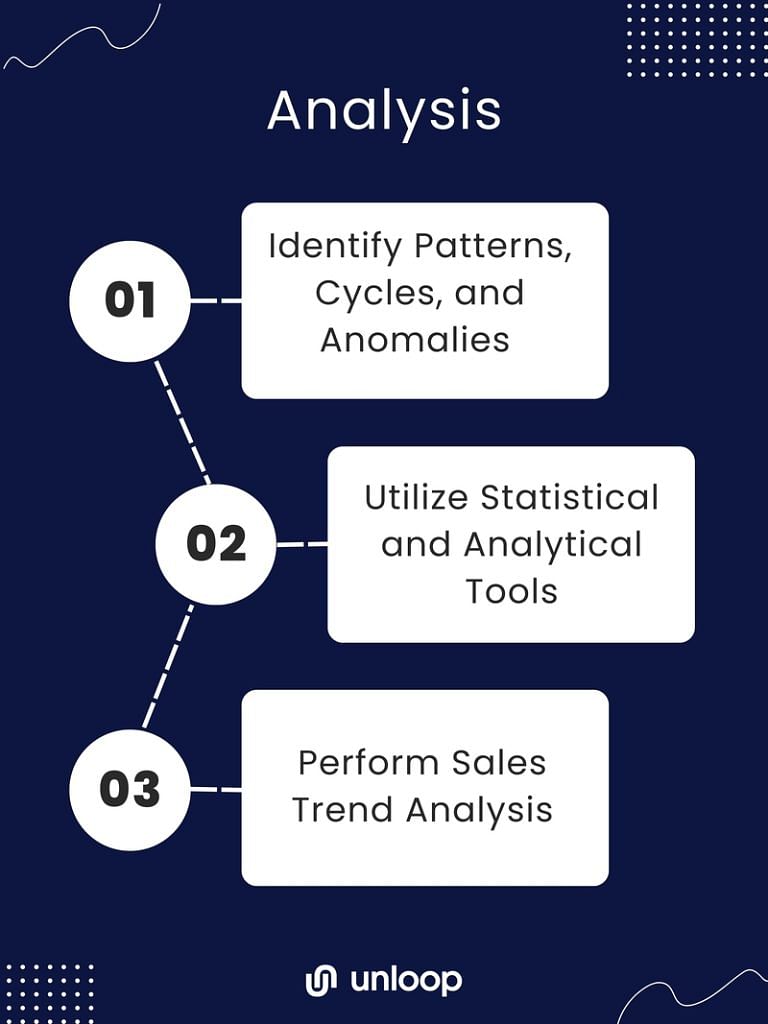
Identify patterns, cycles, and anomalies in your sales data. Once you notice the trends, you can come up with study and develop conclusions about your customers and the market.
Companies often rely on statistical and analytical tools to conduct STA effectively. These tools help to accurately measure and interpret sales patterns and fluctuations, identify key trends, and make data-driven decisions. From regression analysis to time-series forecasting models, these tools enable you to uncover hidden insights within your sales data.
However, merely identifying trends is not enough; it is equally crucial to interpret and understand the implications of these trends. You must assess whether the observed sales upwards or downwards shift trend is sustainable or just seasonal.
Understanding the implications of sales trends helps you adjust your strategies, make informed decisions, and adapt business operations accordingly. For example, a declining trend in sales may indicate the need for marketing efforts to reach new customers or develop new products. Seasonal sales cycles may need inventory levels or staffing adjustments.
After doing an STA, you can further use data for sales forecasting. By leveraging historical data, implementing suitable forecasting models, and considering internal and external factors, you can gain meaningful insights into sales trends, facilitating better decision-making and maximizing profitability.
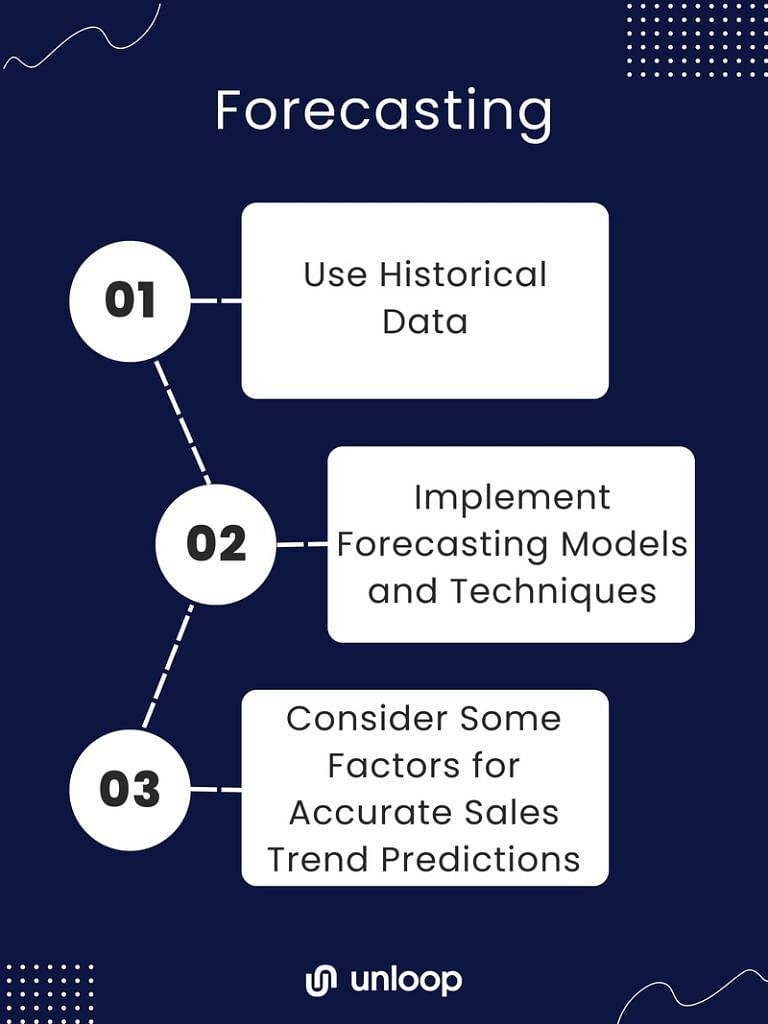
Historical sales data provides valuable insights into past performance, allowing you to identify patterns and trends. By analyzing previous sales figures, companies can determine seasonal fluctuations, identify successful marketing strategies, and forecast future sales based on historical patterns.
You can employ various forecasting models and techniques to predict sales trends accurately. These include quantitative methods like time series and regression analysis and qualitative methods like expert opinions and market research surveys. Employing a combination of techniques can enhance the accuracy of sales trend predictions.
To ensure accurate sales trend predictions, consider these:
Considering these components allows you to make more precise sales forecasts, enabling them to allocate resources effectively, streamline production, and adjust sales strategies accordingly.
Applying STA to business strategy provides valuable insights for improving areas of weakness, targeting the right markets, optimizing resource allocation, and staying adaptable. Businesses can leverage these insights to elevate their performance and drive sustained growth.
Analyze sales trends to identify areas for improvement. By studying patterns in customer behavior and sales data, you can pinpoint areas of weakness and take corrective measures including product feature improvement, perfecting customer service, or refining pricing strategies.
STA enables you to adjust your sales strategies and target markets. By closely monitoring trends, you can understand shifts in customer preferences, buying habits, or industry trends. With this knowledge, businesses can realign their sales tactics and focus on target markets that show growth potential.
STA helps identify high-potential areas where resources are best allocated. This ensures that marketing and sales efforts are focused on segments with the highest likelihood of yielding positive results.
Organizations like yours can identify emerging opportunities or threats by continuously evaluating sales trends and adjusting their sales strategy accordingly. Through this, you can stay flexible and adaptable to market changes.
Regarding STA, a range of software and tools are available to assist you in understanding and interpreting sales data. Some popular options include CRM software, business intelligence platforms, and data visualization tools. These tools include tracking sales metrics, generating reports, and providing predictive analytics.
Evaluating and selecting the right tools for specific needs requires careful consideration. You should assess your business requirements and goals before making a decision. Factors to consider include:
Integrate Analysis Tools Into Existing Systems
Integrate STA tools into your existing systems to ensure seamless data flow and avoid duplication of efforts. The tool you select should be able to integrate with other systems, such as CRM, ERP, or POS software, to gather data automatically.
This integration allows for you to create powerful dashboards for real-time data analysis. It also reduces manual data entry and enhances the accuracy of the insights gained. Additionally, system integration enables data sharing across different departments and management teams, facilitating collaboration and informed decision-making throughout the organization.
STA is a crucial component of strategic business planning, but it also comes with challenges and pitfalls. Knowing the difficulties in handling this task makes you more prepared in case you face them. You can also proactively avoid them by following some best practices.
| Challenges and Pitfalls | Best Practices |
Mastering STA is paramount for sustained success. We hope this guide has provided you with tools to decode market fluctuations and customer behaviors to help you decide better for your business.
The work will be lighter if you seek assistance and partner with experts, just like our team at Unloop. Our team is trained in bookkeeping, data gathering and management as well as financial reporting, so you won't find it difficult to collate, organize, and make sense of business data.
Let us help you do your trend analysis correctly. Contact us now!
Sales trend analysis (STA) is the cornerstone of sustainable business growth, so knowing its ins and outs is essential. As a rookie in the field, you must still be in the stage of learning the ropes, so we're here to help you.
This guide will equip you with essential skills to decipher market fluctuations, customer behaviors, and emerging patterns. We delve deep into sales data analysis techniques, empowering you to make informed decisions, optimize inventory, enhance customer experiences, and boost profitability.
From leveraging advanced analytics tools to practical tips on interpreting consumer preferences, this comprehensive resource is your road map to navigating the ever-changing ecommerce terrain. So, let's begin!
Making informed decisions and developing strategies are some benefits of STA. By understanding the underlying trends, companies can anticipate market demand, identify high-performing products or services, and focus on areas that require improvement.
A comprehensive sales analysis must consider these key components and factors.
((Current Period Value - Base Period Value) / Base Period Value) * 100
Getting the answer involves gathering historical sales data and ensuring all the gathered details are accurate and updated. The answers will provide patterns or deviations over a specified period. By analyzing these trends, you’ll know the behavior of your target market and base your decisions on data instead of instinct.
| Key Metrics | |
| Revenue and Sales Growth Trends | Check sales revenue over a specific time Project business financial health Provide efficiency insights of sales strategies and marketing efforts |
| Customer Acquisition and Retention Trends | Show new customers acquisition rate Check efficiency of customer retention game plans Determine customer acquisition and retention processes pain points |
| Product or Service Performance Trends | Evaluate products and services performance based on sales and customer feedback Determine the success and popularity of specific offerings Help identify potential opportunities for product or service improvements |
| Market and Industry Trends | Assess the overall state and direction of the market and industry Identify emerging trends and changes that can impact sales and revenue Help you formulate the latest strategies at par with competitors |
| Competitor Sales Data Analysis and Benchmarking | Analyze the performance of competitors in the market Identify strengths and weaknesses of competitors' sales strategies Benchmark against industry peers to measure performance and identify areas for improvement. |
Gathering Data
If you want to make data gathering easier, keep an eye on the details and establish a process too. How so? You can check out the details below.

Identifying the sources that provide accurate and reliable data for analysis is crucial. This may include internal sources such as Customer Relationship Management (CRM) systems, different kinds of reports, and customer data. External sources like market research reports, industry publications, and competitor analysis can give you better financial judgment when monitored.
Once the relevant data sources are identified, collect and organize them. Capture data consistently over time using standardized formats, and maintain proper documentation. Because automated tools and data management systems are champions in streamlining collection, organization of information from various channels are done swiftly.
Validate the collected data to eliminate duplicates or errors and address inconsistencies. Regular audits and cross-checking with multiple sources help ensure reliable figures for analysis.
After gathering data and keeping them organized, you must know how to make sense of them, and below are just some ways to do so.

Identify patterns, cycles, and anomalies in your sales data. Once you notice the trends, you can come up with study and develop conclusions about your customers and the market.
Companies often rely on statistical and analytical tools to conduct STA effectively. These tools help to accurately measure and interpret sales patterns and fluctuations, identify key trends, and make data-driven decisions. From regression analysis to time-series forecasting models, these tools enable you to uncover hidden insights within your sales data.
However, merely identifying trends is not enough; it is equally crucial to interpret and understand the implications of these trends. You must assess whether the observed sales upwards or downwards shift trend is sustainable or just seasonal.
Understanding the implications of sales trends helps you adjust your strategies, make informed decisions, and adapt business operations accordingly. For example, a declining trend in sales may indicate the need for marketing efforts to reach new customers or develop new products. Seasonal sales cycles may need inventory levels or staffing adjustments.
After doing an STA, you can further use data for sales forecasting. By leveraging historical data, implementing suitable forecasting models, and considering internal and external factors, you can gain meaningful insights into sales trends, facilitating better decision-making and maximizing profitability.

Historical sales data provides valuable insights into past performance, allowing you to identify patterns and trends. By analyzing previous sales figures, companies can determine seasonal fluctuations, identify successful marketing strategies, and forecast future sales based on historical patterns.
You can employ various forecasting models and techniques to predict sales trends accurately. These include quantitative methods like time series and regression analysis and qualitative methods like expert opinions and market research surveys. Employing a combination of techniques can enhance the accuracy of sales trend predictions.
To ensure accurate sales trend predictions, consider these:
Considering these components allows you to make more precise sales forecasts, enabling them to allocate resources effectively, streamline production, and adjust sales strategies accordingly.
Applying STA to business strategy provides valuable insights for improving areas of weakness, targeting the right markets, optimizing resource allocation, and staying adaptable. Businesses can leverage these insights to elevate their performance and drive sustained growth.
Analyze sales trends to identify areas for improvement. By studying patterns in customer behavior and sales data, you can pinpoint areas of weakness and take corrective measures including product feature improvement, perfecting customer service, or refining pricing strategies.
STA enables you to adjust your sales strategies and target markets. By closely monitoring trends, you can understand shifts in customer preferences, buying habits, or industry trends. With this knowledge, businesses can realign their sales tactics and focus on target markets that show growth potential.
STA helps identify high-potential areas where resources are best allocated. This ensures that marketing and sales efforts are focused on segments with the highest likelihood of yielding positive results.
Organizations like yours can identify emerging opportunities or threats by continuously evaluating sales trends and adjusting their sales strategy accordingly. Through this, you can stay flexible and adaptable to market changes.
Regarding STA, a range of software and tools are available to assist you in understanding and interpreting sales data. Some popular options include CRM software, business intelligence platforms, and data visualization tools. These tools include tracking sales metrics, generating reports, and providing predictive analytics.
Evaluating and selecting the right tools for specific needs requires careful consideration. You should assess your business requirements and goals before making a decision. Factors to consider include:
Integrate Analysis Tools Into Existing Systems
Integrate STA tools into your existing systems to ensure seamless data flow and avoid duplication of efforts. The tool you select should be able to integrate with other systems, such as CRM, ERP, or POS software, to gather data automatically.
This integration allows for you to create powerful dashboards for real-time data analysis. It also reduces manual data entry and enhances the accuracy of the insights gained. Additionally, system integration enables data sharing across different departments and management teams, facilitating collaboration and informed decision-making throughout the organization.
STA is a crucial component of strategic business planning, but it also comes with challenges and pitfalls. Knowing the difficulties in handling this task makes you more prepared in case you face them. You can also proactively avoid them by following some best practices.
| Challenges and Pitfalls | Best Practices |
Mastering STA is paramount for sustained success. We hope this guide has provided you with tools to decode market fluctuations and customer behaviors to help you decide better for your business.
The work will be lighter if you seek assistance and partner with experts, just like our team at Unloop. Our team is trained in bookkeeping, data gathering and management as well as financial reporting, so you won't find it difficult to collate, organize, and make sense of business data.
Let us help you do your trend analysis correctly. Contact us now!
Are there moments you find yourself asking, “How often should you reconcile your bank account?”
Bank account reconciliation is an essential practice for maintaining financial accuracy and ensuring timely reporting. The task involves comparing your business's accounting records to your bank statement, identifying any discrepancies, and making necessary adjustments.
Through bank account reconciliation, you are sure that your financial records are accurate. Regularly reconciling your bank account not only helps to identify potential errors or fraudulent activity but also provides insight into your company's cash flow. By staying on top of these reconciliations, you can confidently make informed decisions.
With these, let us know the appropriate frequency for reconciling your bank account to achieve your goals and the benefits that come with it.
Bank reconciliation should be done on a regular basis, preferably monthly or quarterly, to ensure accuracy between bank statements and accounting records and to detect any discrepancies or errors.
To help you decide better on how often you should do your business bank reconciliation, let us go through the benefits of the different schedules and the process in doing them.
Performing weekly bank reconciliations can help you maintain up-to-date financial records and monitor your cash flow effectively. By reconciling your bank account and books weekly, you can spot any discrepancies or potential fraud early on, allowing for swift resolution.
Weekly reconciliation assists you in managing your cash account and accounts receivable more effectively, avoiding overdraft fees, and ensuring sufficient funds for accounts payable.
To perform a weekly reconciliation, have a daily balance sheet and bank statement comparison. Identify and resolve any discrepancies, such as bank errors, adjusting journal entries, or unusual transactions. Reconcile each transaction individually to ensure accuracy.
Monthly reconciliation is crucial for tracking and controlling your business's cash flow and financial health. Banks typically send monthly statements for the previous month, making it essential to reconcile your books and bank balance regularly. By performing a monthly reconciliation, you can catch any missed payments, double payments, or accounting errors.
Focus on your daily and weekly cash account balance, and compare it with the bank statement balance. Make sure that outstanding checks, deposits in transit, bank charges, and interest income are all included in the details. If you find any discrepancies, make any necessary adjustments to journal entries or correct calculation errors for accuracy.
Conducting quarterly or annual reconciliations provides an opportunity to review your financial records comprehensively, identifying any possible fraud or accounting errors that may have gone unnoticed during the weekly and monthly processes.
A more in-depth review of your financial records at the end of a quarter or fiscal year allows for a thorough analysis of your cash accounts, accounts payable, and accounts receivable.
Compile the bank statements for the entire quarter or year and compare them with your cash account and general ledger. Review the bank accounts for any unexplained transactions or discrepancies not identified during the weekly or monthly reconciliations. Make any necessary adjusting journal entries to correct discrepancies.
When considering how often to reconcile your bank account, consider the factors below too. These details can influence the best frequency for timely and accurate financial reporting.
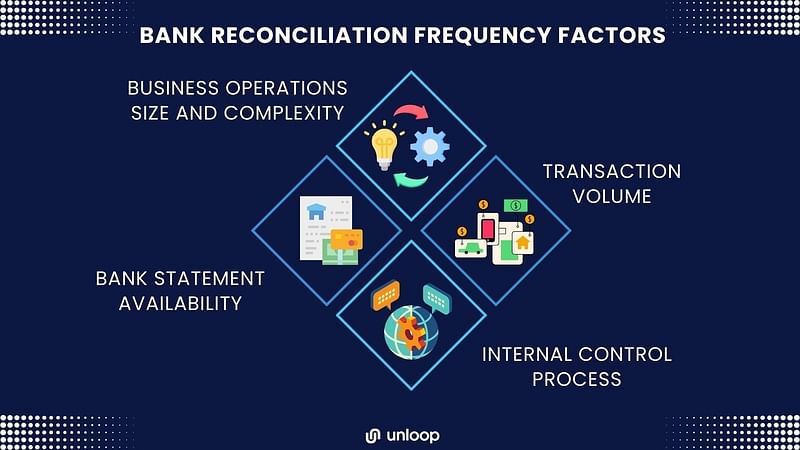
Larger businesses with more complex operations may need to reconcile their bank accounts more frequently, as they are likely to have more transactions and a higher risk of fraud or accounting errors. Smaller businesses with fewer transactions, on the other hand, may be able to perform bank reconciliations less frequently, such as on a monthly basis, without sacrificing the accuracy of their financial reporting.
A higher volume of transactions can lead to more potential discrepancies between your cash account and your bank statement. Therefore, if your business has a high volume of transactions, it may be more efficient and accurate to reconcile your bank account more frequently, such as weekly or even daily. Conversely, businesses with lower transaction volumes might find it sufficient to reconcile their accounts on a monthly basis.
The frequency at which your bank provides statements will also influence reconciliation prevalence. Typically, banks send monthly statements, which aligns well with a monthly reconciliation schedule. However, with online banking and access to daily transaction updates, you may choose to reconcile your account more frequently to stay on top of your financial records.
The strength of your internal control processes will play a role in bank reconciliation frequency. Segregation of duties and a thorough review process will allow for timely identification and resolution of discrepancies. You can minimize the risk of fraud and accounting errors whether you choose to reconcile your bank account daily, weekly, or monthly.
Reconciling your bank account regularly for timely and accurate financial reporting will be easier with the various software available. The tools below can help streamline your bank reconciliation process to improve efficiency and reduce errors.
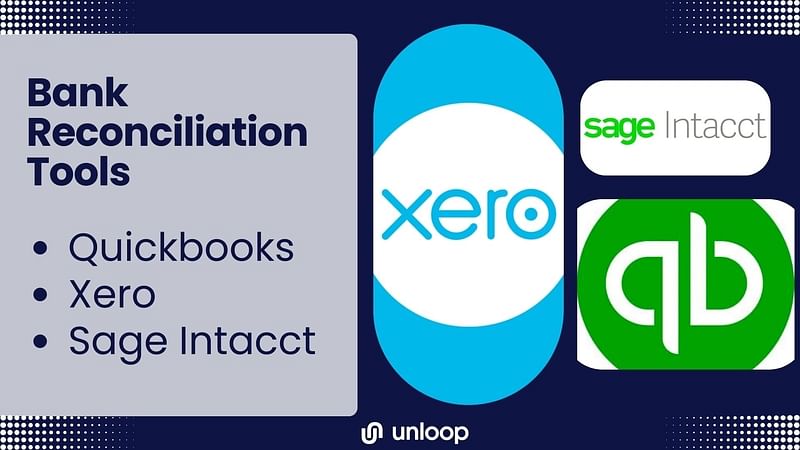
You cannot miss QuickBooks in accounting. This tool offers features for reconciling bank accounts and credit card transactions, making it easier for you to identify discrepancies in your financial records and keeping financial data correct and updated.
Another accounting software that can assist in your reconciliation process is Xero. Xero provides tools for bank reconciliation, allowing you to efficiently track and match transactions. Its bank feed feature also reduces manual effort and increases accuracy.
Sage Intacct offers automated bank reconciliation capabilities. This cloud-based accounting tool helps you streamline the process and identify bank errors or discrepancies in your financial records quickly and efficiently.
BlackLine Account Reconciliation is an enterprise-grade solution that enables users to streamline the reconciliation process, improve productivity, and ensure accuracy.
ReconArt is a comprehensive reconciliation software that provides a unified platform for performing reconciliations across various accounts and sources.
FloQast is an accounting workflow automation platform that includes reconciliation capabilities, facilitating collaboration and ensuring accuracy during the process.
SAP S/4HANA is an integrated enterprise resource planning (ERP) system that includes built-in reconciliation functionality, minimizing manual effort and maximizing efficiency.
By now, you already have an idea on how often you should do your bank reconciliation for your business. But before you get going check out these mistakes and challenges first. By being aware of these common mistakes and challenges, you can ensure a more timely and accurate bank reconciliation process.
Bank account reconciliation is essential for maintaining accurate financial records and identifying discrepancies before they escalate. By reconciling your accounts on a regular basis, you can ensure the integrity of your cash flow and make informed financial decisions.
For seamless bookkeeping and expert assistance with bank reconciliations, consider partnering with us here Unloop. With our range of financial services, from accounts payable, payroll, and tax assistance, we'll help you keep your records up to date and accurate, giving you peace of mind and more time to focus on growing your business.
Contact us now to get started!
Are there moments you find yourself asking, “How often should you reconcile your bank account?”
Bank account reconciliation is an essential practice for maintaining financial accuracy and ensuring timely reporting. The task involves comparing your business's accounting records to your bank statement, identifying any discrepancies, and making necessary adjustments.
Through bank account reconciliation, you are sure that your financial records are accurate. Regularly reconciling your bank account not only helps to identify potential errors or fraudulent activity but also provides insight into your company's cash flow. By staying on top of these reconciliations, you can confidently make informed decisions.
With these, let us know the appropriate frequency for reconciling your bank account to achieve your goals and the benefits that come with it.
Bank reconciliation should be done on a regular basis, preferably monthly or quarterly, to ensure accuracy between bank statements and accounting records and to detect any discrepancies or errors.
To help you decide better on how often you should do your business bank reconciliation, let us go through the benefits of the different schedules and the process in doing them.
Performing weekly bank reconciliations can help you maintain up-to-date financial records and monitor your cash flow effectively. By reconciling your bank account and books weekly, you can spot any discrepancies or potential fraud early on, allowing for swift resolution.
Weekly reconciliation assists you in managing your cash account and accounts receivable more effectively, avoiding overdraft fees, and ensuring sufficient funds for accounts payable.
To perform a weekly reconciliation, have a daily balance sheet and bank statement comparison. Identify and resolve any discrepancies, such as bank errors, adjusting journal entries, or unusual transactions. Reconcile each transaction individually to ensure accuracy.
Monthly reconciliation is crucial for tracking and controlling your business's cash flow and financial health. Banks typically send monthly statements for the previous month, making it essential to reconcile your books and bank balance regularly. By performing a monthly reconciliation, you can catch any missed payments, double payments, or accounting errors.
Focus on your daily and weekly cash account balance, and compare it with the bank statement balance. Make sure that outstanding checks, deposits in transit, bank charges, and interest income are all included in the details. If you find any discrepancies, make any necessary adjustments to journal entries or correct calculation errors for accuracy.
Conducting quarterly or annual reconciliations provides an opportunity to review your financial records comprehensively, identifying any possible fraud or accounting errors that may have gone unnoticed during the weekly and monthly processes.
A more in-depth review of your financial records at the end of a quarter or fiscal year allows for a thorough analysis of your cash accounts, accounts payable, and accounts receivable.
Compile the bank statements for the entire quarter or year and compare them with your cash account and general ledger. Review the bank accounts for any unexplained transactions or discrepancies not identified during the weekly or monthly reconciliations. Make any necessary adjusting journal entries to correct discrepancies.
When considering how often to reconcile your bank account, consider the factors below too. These details can influence the best frequency for timely and accurate financial reporting.

Larger businesses with more complex operations may need to reconcile their bank accounts more frequently, as they are likely to have more transactions and a higher risk of fraud or accounting errors. Smaller businesses with fewer transactions, on the other hand, may be able to perform bank reconciliations less frequently, such as on a monthly basis, without sacrificing the accuracy of their financial reporting.
A higher volume of transactions can lead to more potential discrepancies between your cash account and your bank statement. Therefore, if your business has a high volume of transactions, it may be more efficient and accurate to reconcile your bank account more frequently, such as weekly or even daily. Conversely, businesses with lower transaction volumes might find it sufficient to reconcile their accounts on a monthly basis.
The frequency at which your bank provides statements will also influence reconciliation prevalence. Typically, banks send monthly statements, which aligns well with a monthly reconciliation schedule. However, with online banking and access to daily transaction updates, you may choose to reconcile your account more frequently to stay on top of your financial records.
The strength of your internal control processes will play a role in bank reconciliation frequency. Segregation of duties and a thorough review process will allow for timely identification and resolution of discrepancies. You can minimize the risk of fraud and accounting errors whether you choose to reconcile your bank account daily, weekly, or monthly.
Reconciling your bank account regularly for timely and accurate financial reporting will be easier with the various software available. The tools below can help streamline your bank reconciliation process to improve efficiency and reduce errors.

You cannot miss QuickBooks in accounting. This tool offers features for reconciling bank accounts and credit card transactions, making it easier for you to identify discrepancies in your financial records and keeping financial data correct and updated.
Another accounting software that can assist in your reconciliation process is Xero. Xero provides tools for bank reconciliation, allowing you to efficiently track and match transactions. Its bank feed feature also reduces manual effort and increases accuracy.
Sage Intacct offers automated bank reconciliation capabilities. This cloud-based accounting tool helps you streamline the process and identify bank errors or discrepancies in your financial records quickly and efficiently.
BlackLine Account Reconciliation is an enterprise-grade solution that enables users to streamline the reconciliation process, improve productivity, and ensure accuracy.
ReconArt is a comprehensive reconciliation software that provides a unified platform for performing reconciliations across various accounts and sources.
FloQast is an accounting workflow automation platform that includes reconciliation capabilities, facilitating collaboration and ensuring accuracy during the process.
SAP S/4HANA is an integrated enterprise resource planning (ERP) system that includes built-in reconciliation functionality, minimizing manual effort and maximizing efficiency.
By now, you already have an idea on how often you should do your bank reconciliation for your business. But before you get going check out these mistakes and challenges first. By being aware of these common mistakes and challenges, you can ensure a more timely and accurate bank reconciliation process.
Bank account reconciliation is essential for maintaining accurate financial records and identifying discrepancies before they escalate. By reconciling your accounts on a regular basis, you can ensure the integrity of your cash flow and make informed financial decisions.
For seamless bookkeeping and expert assistance with bank reconciliations, consider partnering with us here Unloop. With our range of financial services, from accounts payable, payroll, and tax assistance, we'll help you keep your records up to date and accurate, giving you peace of mind and more time to focus on growing your business.
Contact us now to get started!
Tax collection and calculation can be a complex and overwhelming process for Amazon sellers like you. It’s especially challenging if you are operating across international borders, between the US and Canada. You surely have wondered, "How is tax calculated on Amazon?"
Let us answer that question and provide you with a comprehensive overview of how taxes are calculated on Amazon for transacting between the US and Canada. From explaining the different types of taxes imposed by both countries to outlining the necessary steps for tax collection, this guide will equip you with the knowledge and tools to navigate the tax landscape on Amazon effortlessly and efficiently.
Amazon calculates its tax based on the applicable tax laws and regulations of the jurisdictions where it operates, taking into account factors such as sales, income, and other taxable criteria.
In the United States, tax charges on Amazon orders depend on various factors, such as the type of item or service sold and the shipping destination or origin. Each state has its own set of sales and use tax rates that need to be considered when calculating taxes on transactions.
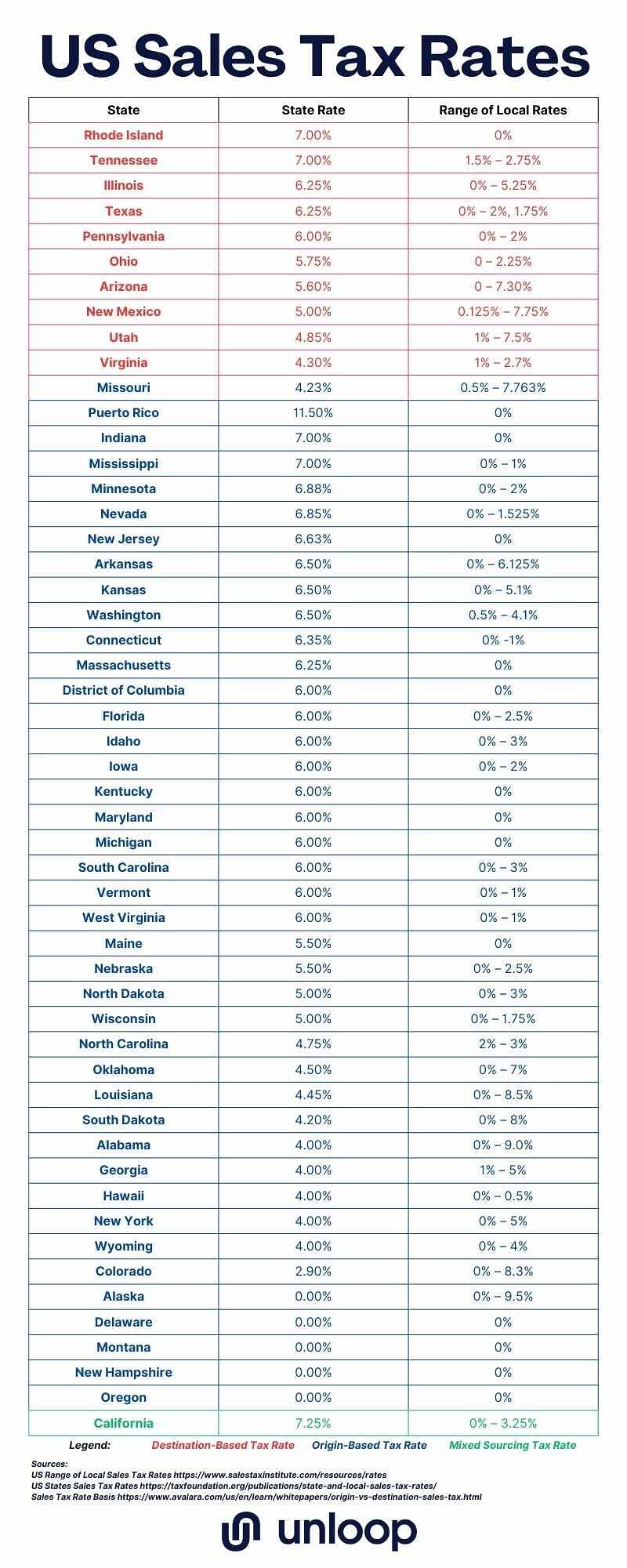
There are two main factors affecting sales taxes in the US: tax nexus and the Marketplace Facilitator Laws (MPF). Let us know what these two mean for your business.
A nexus is a legal term used to describe a significant presence in a state. It can be based on several factors, such as the location of your offices, employees, warehouses, or fulfillment centers. If your business has a nexus in a state where it sells products, you must collect and remit sales taxes for that state.
You can skip the hassle of collecting and remitting sales taxes on Amazon as the MPF mandates the e-commerce giant do this. Nevertheless, Amazon does not cover local sales taxes not listed on the MPF. In these cases, you have to collect and remit them yourself.
To make your US sales tax calculation and compliance on the platform easier, here are some steps you can follow.
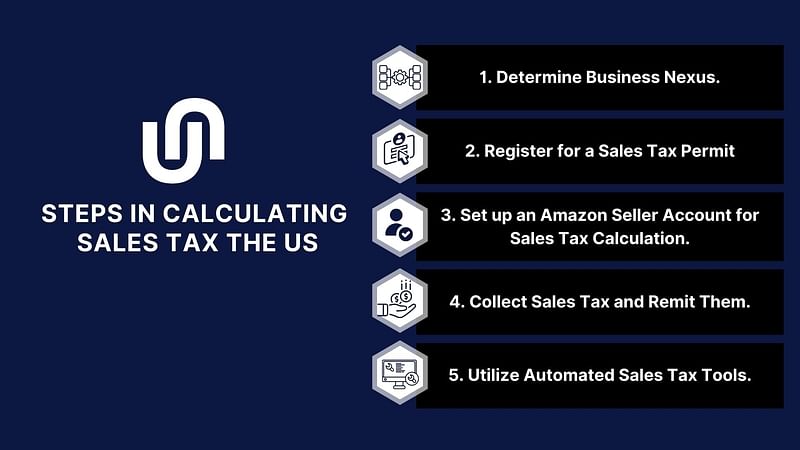
Identify if you have a sales tax nexus in the states where you sell your products. This includes evaluating if you have a physical presence or economic nexus.
Remember that it's illegal to collect Amazon sales tax without a permit, so make sure to register at the state's revenue department.
In your Amazon Seller Central account, set up your sales tax settings. Input the states where you need to collect sales tax, and assign product tax codes to your items to ensure the correct tax rates are applied.
Once your tax settings are configured, Amazon will automatically collect the appropriate sales tax based on the applicable tax rates for each state. Amazon will be responsible for remitting collected sales tax to the relevant tax authorities.
Consider using automated sales tax tools to help you in tracking, sales tax reporting, and filing your sales tax return. These tools can minimize human errors, save time, and help you comply with ever-changing sales tax laws.
Sales tax in Canada includes the different provincial taxes. With different rates applied to individual provinces, you must know the specific tax breakdown. Taxes include the Goods and Services Tax (GST), Provincial Sales Tax (PST), Harmonized Sales Tax (HST), and Quebec Sales Tax (QST). Each of which is determined by the selling price and shipping destination unless stated otherwise.
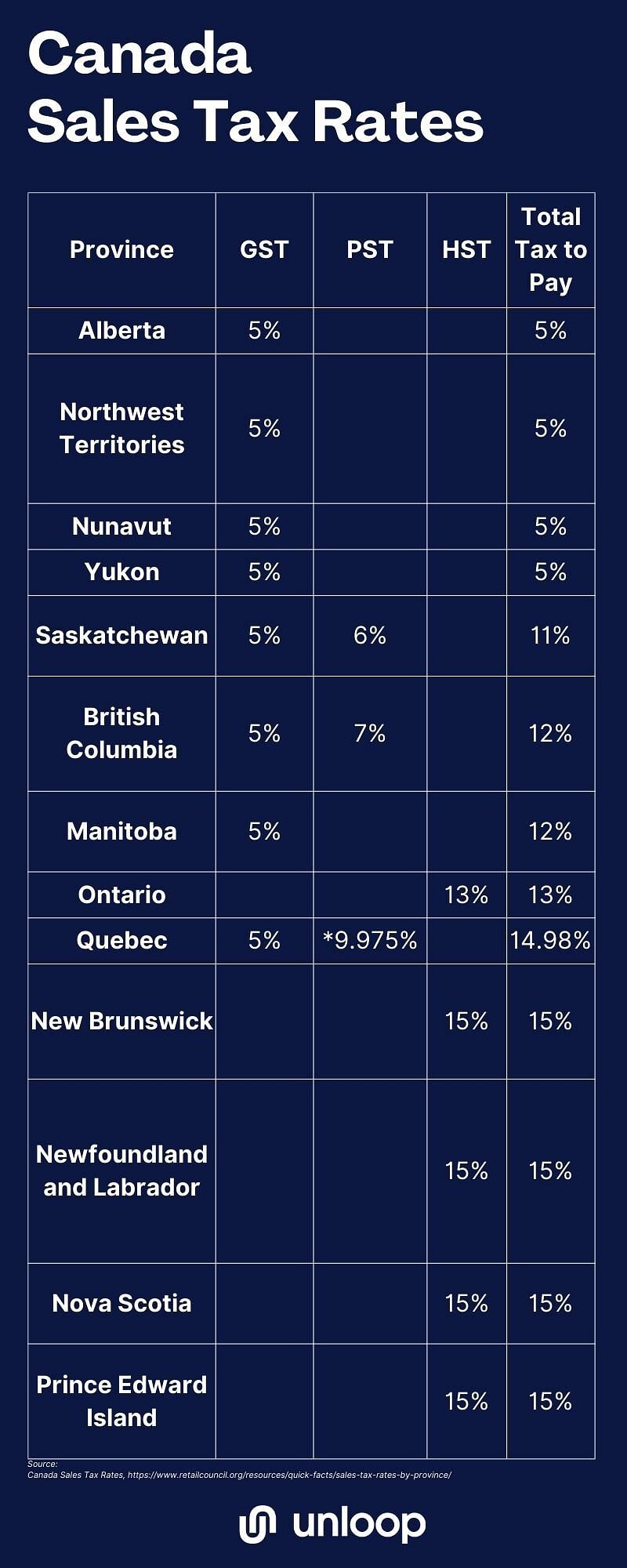
There are three main types of sales taxes in Canada. Each province and territory has its own PST rate and rules. Some locations have combined GST and PST into an HST.
The GST rate is 5%, and it is applied to most goods and services sold in the country. The collected taxes are used to fund public services and programs.
PST is a sales tax levied by individual provinces in Canada on the retail sale or lease of most goods and some services.
HST, on the other hand, is a combined federal and provincial sales tax that applies in provinces that have chosen to harmonize their sales tax with the federal GST. HST rates can be up to 15%.
To ensure compliance with Canadian tax laws, follow these steps:
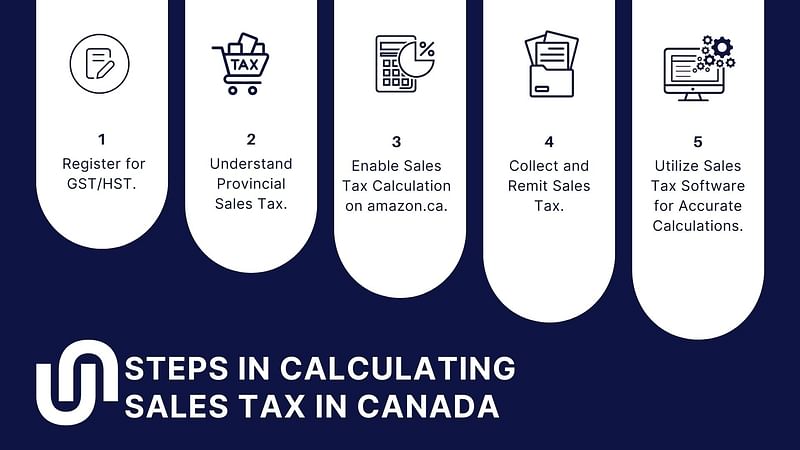
To collect and remit sales taxes, register to the Canada Revenue Agency (CRA), especially if your annual sales meet or exceed CAD 30,000.
Research the tax rates and rules for each location where you have a nexus to understand the specific PST or HST rates for each province or territory where you have a tax nexus.
Customize your tax settings in your Amazon Seller Central account to reflect the tax rates and rules of the provinces or territories where you have a nexus.
For tax-liable transactions on Amazon, the platform will automatically collect sales tax from customers at the specified rates in your tax settings. Amazon, through the MPF, files sales tax reports, and remits collected taxes to the CRA accordingly.
To make the sales tax calculation process easier and maintain accuracy, consider using sales tax software. These tools can automatically track tax rates, generate reports, and assist with the filing process if you integrate them into your Amazon Seller Central account.
You are well on your way now that you know how sales taxes work in the US and Canada. To ensure you'll do the tax calculation, collection, and remittance properly, here are some of the best practices you can follow.
To successfully navigate the US and Canadian sales tax on Amazon, stay updated with the latest tax laws and regulations in both countries. US sales tax is based on the combined state and local rates where your order is delivered to or from, while in Canada, businesses are obligated to register and collect GST, PST, or HST.
Using tax automation software can help simplify the tax calculation process on Amazon. These tools integrate with your Amazon Seller Central account and help to ensure accurate sales tax collection, management, and reporting. Through automation, you can minimize errors and allot saved time to essential business tasks.
Some tax software worth trying are the following:
Before selecting a tax software, consider your specific tax needs and consult with a tax professional or advisor to determine which software is best suited for your business.
Proper record-keeping is essential for tax compliance and accurate financial reporting. Maintain detailed records of your sales data, tax rates, and collected taxes. This practice will prove useful when filing sales tax returns, generating tax reports, and ensuring you remit the correct sales tax amount to the relevant tax authorities.
If you're unsure about tax laws or have complex tax situations, don't hesitate to seek professional assistance. Tax experts can help you navigate the intricacies of US and Canadian sales tax regulations, maintain compliance with tax requirements, and guide you in making informed decisions.
Calculating tax accurately on your Amazon sales is crucial to maintaining compliance with tax laws in the US and Canada. With proper tax calculation, you can avoid overcharging or undercharging sales tax on your transactions, ensuring smooth business operations and keeping customers satisfied and loyal.
To implement best practices for effective sales tax calculation, you can get valuable assistance from us here at Unloop. We offer comprehensive guidance on navigating taxes, helping you avoid common pitfalls and maintain compliance with tax authorities.
Take the first step in managing your sales tax obligations effectively by partnering with us. Let our expertise guide you through the complexities of tax calculation and compliance on Amazon, allowing you to focus on growing your business.
Book a call now!
Tax collection and calculation can be a complex and overwhelming process for Amazon sellers like you. It’s especially challenging if you are operating across international borders, between the US and Canada. You surely have wondered, "How is tax calculated on Amazon?"
Let us answer that question and provide you with a comprehensive overview of how taxes are calculated on Amazon for transacting between the US and Canada. From explaining the different types of taxes imposed by both countries to outlining the necessary steps for tax collection, this guide will equip you with the knowledge and tools to navigate the tax landscape on Amazon effortlessly and efficiently.
Amazon calculates its tax based on the applicable tax laws and regulations of the jurisdictions where it operates, taking into account factors such as sales, income, and other taxable criteria.
In the United States, tax charges on Amazon orders depend on various factors, such as the type of item or service sold and the shipping destination or origin. Each state has its own set of sales and use tax rates that need to be considered when calculating taxes on transactions.

There are two main factors affecting sales taxes in the US: tax nexus and the Marketplace Facilitator Laws (MPF). Let us know what these two mean for your business.
A nexus is a legal term used to describe a significant presence in a state. It can be based on several factors, such as the location of your offices, employees, warehouses, or fulfillment centers. If your business has a nexus in a state where it sells products, you must collect and remit sales taxes for that state.
You can skip the hassle of collecting and remitting sales taxes on Amazon as the MPF mandates the e-commerce giant do this. Nevertheless, Amazon does not cover local sales taxes not listed on the MPF. In these cases, you have to collect and remit them yourself.
To make your US sales tax calculation and compliance on the platform easier, here are some steps you can follow.

Identify if you have a sales tax nexus in the states where you sell your products. This includes evaluating if you have a physical presence or economic nexus.
Remember that it's illegal to collect Amazon sales tax without a permit, so make sure to register at the state's revenue department.
In your Amazon Seller Central account, set up your sales tax settings. Input the states where you need to collect sales tax, and assign product tax codes to your items to ensure the correct tax rates are applied.
Once your tax settings are configured, Amazon will automatically collect the appropriate sales tax based on the applicable tax rates for each state. Amazon will be responsible for remitting collected sales tax to the relevant tax authorities.
Consider using automated sales tax tools to help you in tracking, sales tax reporting, and filing your sales tax return. These tools can minimize human errors, save time, and help you comply with ever-changing sales tax laws.
Sales tax in Canada includes the different provincial taxes. With different rates applied to individual provinces, you must know the specific tax breakdown. Taxes include the Goods and Services Tax (GST), Provincial Sales Tax (PST), Harmonized Sales Tax (HST), and Quebec Sales Tax (QST). Each of which is determined by the selling price and shipping destination unless stated otherwise.

There are three main types of sales taxes in Canada. Each province and territory has its own PST rate and rules. Some locations have combined GST and PST into an HST.
The GST rate is 5%, and it is applied to most goods and services sold in the country. The collected taxes are used to fund public services and programs.
PST is a sales tax levied by individual provinces in Canada on the retail sale or lease of most goods and some services.
HST, on the other hand, is a combined federal and provincial sales tax that applies in provinces that have chosen to harmonize their sales tax with the federal GST. HST rates can be up to 15%.
To ensure compliance with Canadian tax laws, follow these steps:

To collect and remit sales taxes, register to the Canada Revenue Agency (CRA), especially if your annual sales meet or exceed CAD 30,000.
Research the tax rates and rules for each location where you have a nexus to understand the specific PST or HST rates for each province or territory where you have a tax nexus.
Customize your tax settings in your Amazon Seller Central account to reflect the tax rates and rules of the provinces or territories where you have a nexus.
For tax-liable transactions on Amazon, the platform will automatically collect sales tax from customers at the specified rates in your tax settings. Amazon, through the MPF, files sales tax reports, and remits collected taxes to the CRA accordingly.
To make the sales tax calculation process easier and maintain accuracy, consider using sales tax software. These tools can automatically track tax rates, generate reports, and assist with the filing process if you integrate them into your Amazon Seller Central account.
You are well on your way now that you know how sales taxes work in the US and Canada. To ensure you'll do the tax calculation, collection, and remittance properly, here are some of the best practices you can follow.
To successfully navigate the US and Canadian sales tax on Amazon, stay updated with the latest tax laws and regulations in both countries. US sales tax is based on the combined state and local rates where your order is delivered to or from, while in Canada, businesses are obligated to register and collect GST, PST, or HST.
Using tax automation software can help simplify the tax calculation process on Amazon. These tools integrate with your Amazon Seller Central account and help to ensure accurate sales tax collection, management, and reporting. Through automation, you can minimize errors and allot saved time to essential business tasks.
Some tax software worth trying are the following:
Before selecting a tax software, consider your specific tax needs and consult with a tax professional or advisor to determine which software is best suited for your business.
Proper record-keeping is essential for tax compliance and accurate financial reporting. Maintain detailed records of your sales data, tax rates, and collected taxes. This practice will prove useful when filing sales tax returns, generating tax reports, and ensuring you remit the correct sales tax amount to the relevant tax authorities.
If you're unsure about tax laws or have complex tax situations, don't hesitate to seek professional assistance. Tax experts can help you navigate the intricacies of US and Canadian sales tax regulations, maintain compliance with tax requirements, and guide you in making informed decisions.
Calculating tax accurately on your Amazon sales is crucial to maintaining compliance with tax laws in the US and Canada. With proper tax calculation, you can avoid overcharging or undercharging sales tax on your transactions, ensuring smooth business operations and keeping customers satisfied and loyal.
To implement best practices for effective sales tax calculation, you can get valuable assistance from us here at Unloop. We offer comprehensive guidance on navigating taxes, helping you avoid common pitfalls and maintain compliance with tax authorities.
Take the first step in managing your sales tax obligations effectively by partnering with us. Let our expertise guide you through the complexities of tax calculation and compliance on Amazon, allowing you to focus on growing your business.
Book a call now!
Taxes can be very challenging because they're very complicated and daunting. It can feel like you pay too much attention to too many things—all at once. Fortunately, the standard deduction is there to simplify things and lessen one's taxable income.
In this article, we will dive into what the standard deduction is, who is eligible for it, and how much it's worth in the federal income tax system this 2023.
The standard deduction is the government's way of conveniently lessening people's taxes. It works by providing a set deductible income per annual accounting period to decrease a payer's taxable income. Standard deduction eliminates the hassle of itemizing deductions annually and gives the lower class more breathing room for taxes.
Age, filing status, and income are the three critical characteristics from your taxpayer's profile that ensure standard deductions are levied fairly by the government. Let’s discuss them one by one.
Age, while not a requirement by the IRS or any related government agencies for tax return filing, can play a role in your standard deductions. For example, being over sixty-five lets taxpayers claim the standard deduction with an additional deduction amount. The same applies to taxpayers who are married and filing jointly, with at least one of them being above sixty-five years old.
Your filing status also affects the standard deduction and whether or not you can use it instead of itemizing deductions. For example, single filers have different standard deductions from married filers, and usually, married filers are given a bigger standard deduction.
Those married filing jointly must decide whether or not to use the standard deduction or lessen their taxable income using itemized deductions instead. For example, if a spouse itemizes deductions, their partner must follow suit. The same goes for the standard deduction.
But this does not mean all married taxpayers are required to file together; taxpayers married filing separately can still file their taxes without following their spouse's preference.
Since the standard deduction decreases your overall taxable income, your earnings play a huge role in determining it. This can be done by subtracting the year's rate of the standard deduction from your income, creating tax exemption, and lowering your overall r income tax.
Using your income also makes using the standard deduction advantageous compared to itemized deductions since the standard deduction is easier. Using your income provides you with a much larger deduction amount than itemizing each qualifying expense.
While age, filing status, and income significantly impact your standard deduction, the rate can still change due to other factors. Here are some characteristics that warrant an increase in standard deduction:
On the other hand, being declared dependent on someone else's federal income tax return reduces one's standard deduction instead of increasing it.
As mentioned in the section about spouses, taxpayers must only use one of the two forms of tax deductions used in a federal tax return for an accounting period: the standard deduction or itemized deductions. But what exactly is the main difference between the two?
| Standard Deduction | Itemized Deduction |
If you choose instead to itemize deductions instead of using the standard deduction, here are some expenses that qualify for tax cuts.
The standard deduction and itemized deductions are essentially the same—they both give people tax cuts and provide them with a fair way of deducting taxes. However, most people tend to gravitate towards using the standard deduction since it usually grants a larger amount, especially after the 2017 Tax Cuts and Job Acts, which inflated the standard deduction and lessened incentives for itemized deductions.
So, in a way, there is no better method of lessening your tax bill. What you can do is calculate your tax bill using both methods and choose the larger amount to ensure you maximize your right to minimize your taxes.
No, the standard deduction rate is not fixed; it changes yearly, as mandated, based on the annual accounting period. What remains the same annually are the qualifications for extra tax deductions, such as differences in filing status and other factors. However, these can change, too, depending again on the tax year.
| Standard Deduction: 2023 Rates |
Taxes, while each citizen's legal responsibility, can be such a hassle. Even with certain deductions in place, it can still be a headache trying to account for them. Fortunately, certain services in the market don't shy away from the numbers.
Unloop is one of the premier accounting services in the market. If you're having trouble with your taxes, try calling us at Unloop—we do taxes, too. Book a call with us here to know more of our services.
Taxes can be very challenging because they're very complicated and daunting. It can feel like you pay too much attention to too many things—all at once. Fortunately, the standard deduction is there to simplify things and lessen one's taxable income.
In this article, we will dive into what the standard deduction is, who is eligible for it, and how much it's worth in the federal income tax system this 2023.
The standard deduction is the government's way of conveniently lessening people's taxes. It works by providing a set deductible income per annual accounting period to decrease a payer's taxable income. Standard deduction eliminates the hassle of itemizing deductions annually and gives the lower class more breathing room for taxes.
Age, filing status, and income are the three critical characteristics from your taxpayer's profile that ensure standard deductions are levied fairly by the government. Let’s discuss them one by one.
Age, while not a requirement by the IRS or any related government agencies for tax return filing, can play a role in your standard deductions. For example, being over sixty-five lets taxpayers claim the standard deduction with an additional deduction amount. The same applies to taxpayers who are married and filing jointly, with at least one of them being above sixty-five years old.
Your filing status also affects the standard deduction and whether or not you can use it instead of itemizing deductions. For example, single filers have different standard deductions from married filers, and usually, married filers are given a bigger standard deduction.
Those married filing jointly must decide whether or not to use the standard deduction or lessen their taxable income using itemized deductions instead. For example, if a spouse itemizes deductions, their partner must follow suit. The same goes for the standard deduction.
But this does not mean all married taxpayers are required to file together; taxpayers married filing separately can still file their taxes without following their spouse's preference.
Since the standard deduction decreases your overall taxable income, your earnings play a huge role in determining it. This can be done by subtracting the year's rate of the standard deduction from your income, creating tax exemption, and lowering your overall r income tax.
Using your income also makes using the standard deduction advantageous compared to itemized deductions since the standard deduction is easier. Using your income provides you with a much larger deduction amount than itemizing each qualifying expense.
While age, filing status, and income significantly impact your standard deduction, the rate can still change due to other factors. Here are some characteristics that warrant an increase in standard deduction:
On the other hand, being declared dependent on someone else's federal income tax return reduces one's standard deduction instead of increasing it.
As mentioned in the section about spouses, taxpayers must only use one of the two forms of tax deductions used in a federal tax return for an accounting period: the standard deduction or itemized deductions. But what exactly is the main difference between the two?
| Standard Deduction | Itemized Deduction |
If you choose instead to itemize deductions instead of using the standard deduction, here are some expenses that qualify for tax cuts.
The standard deduction and itemized deductions are essentially the same—they both give people tax cuts and provide them with a fair way of deducting taxes. However, most people tend to gravitate towards using the standard deduction since it usually grants a larger amount, especially after the 2017 Tax Cuts and Job Acts, which inflated the standard deduction and lessened incentives for itemized deductions.
So, in a way, there is no better method of lessening your tax bill. What you can do is calculate your tax bill using both methods and choose the larger amount to ensure you maximize your right to minimize your taxes.
No, the standard deduction rate is not fixed; it changes yearly, as mandated, based on the annual accounting period. What remains the same annually are the qualifications for extra tax deductions, such as differences in filing status and other factors. However, these can change, too, depending again on the tax year.
| Standard Deduction: 2023 Rates |
Taxes, while each citizen's legal responsibility, can be such a hassle. Even with certain deductions in place, it can still be a headache trying to account for them. Fortunately, certain services in the market don't shy away from the numbers.
Unloop is one of the premier accounting services in the market. If you're having trouble with your taxes, try calling us at Unloop—we do taxes, too. Book a call with us here to know more of our services.
Most capital used in starting a business goes into buying assets for the company. These assets are then used to generate income for the business. However, tangible assets tend to lose value over time and garner a hefty tax bill for a business expense, making it important to learn how to calculate depreciation.
In this article, we'll discuss depreciation, the four ways of calculating it, and the kind of assets you can expect to save money on.
Depreciation is when tangible assets a company invests in loses its value over time due to the typical wear-and-tear of products or equipment. It is an accounting term that determines what an asset is worth. Knowing an item's value is important for businesses to save money from depreciation expenses. It is also essential in monitoring your financial records.
Assets depreciate at different rates. For example, factory equipment may depreciate faster than a company car. There are different ways of calculating depreciation for both. Different factors like asset cost and salvage value come into play to determine the depreciation value of an asset.
Here are four methods to determine depreciation with their respective formulas.
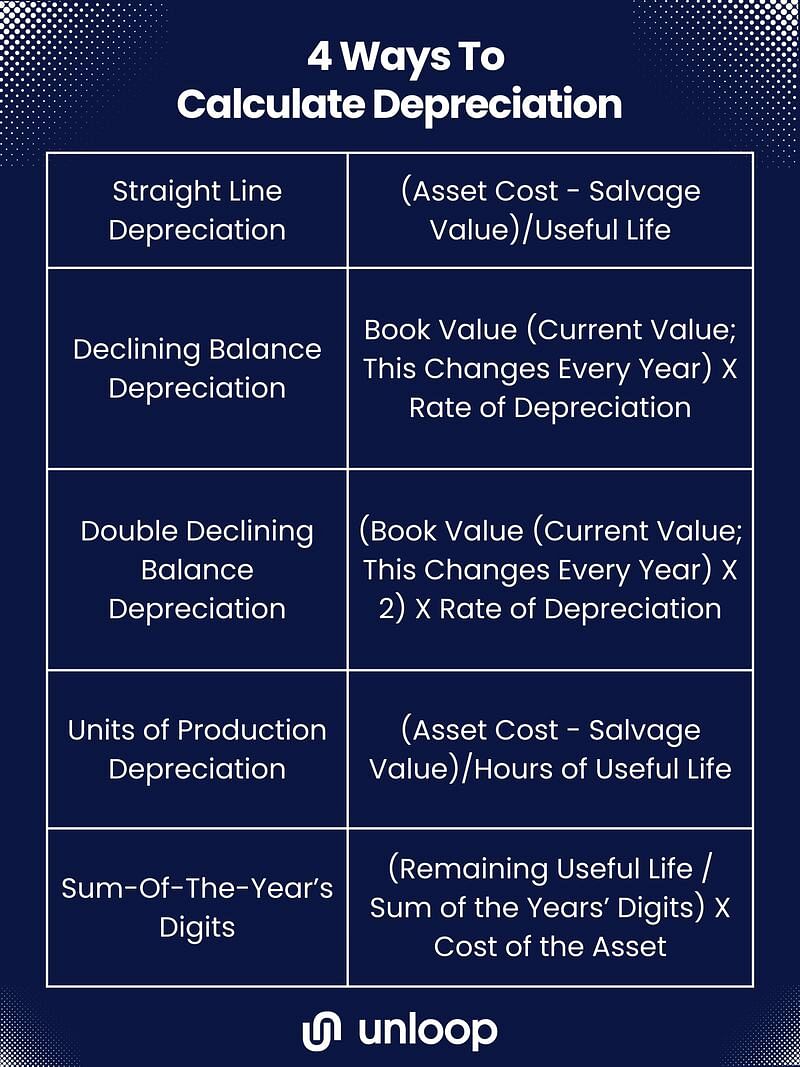
The straight-line depreciation method is the most common form of calculating depreciation, and it's pretty straightforward. All you have to do is subtract the salvage value from the asset's cost and divide the difference using the asset's useful life in years. The company determines the salvage value, and should be a reasonable amount based on IRS rules.
If a business or organization wants to dispose of assets that lose value quicker, like a company car, the declining balance depreciation method is the best way to go. The declining and double-declining balance methods show assets that depreciate faster, so companies can get more value from depreciation deductions sooner.
To get the depreciation value for a declining balance, you have to multiply the beginning book value of an asset by the rate of depreciation. (To get the depreciation rate, divide 100% by the years of an asset's expected life.)
The same formula applies to the double declining balance method, except you double the amount of the book value. The double declining balance method is typically used to accelerate an asset's depreciation value for taxable income.
Machinery or equipment depreciates at a different rate than other assets because they are used constantly. Their production function defines how much these tools have been used. The method used for depreciating production units is called units of production depreciation.
To get units of production depreciation, follow the straight-line depreciation formula, except use an asset's useful life in hours instead of years.
The sum-of-the-year's digits method, also known as the accelerated depreciation method, is used to depreciate an asset without losing its value, allowing it to retain its value upon disposal. You can get a more even depreciation value over the years using the SYD method.
Getting the depreciation using the SYD method can be complicated. To calculate SYD, divide what's left of an asset's useful life by the sum of years. The SYD is an asset's productive life added together. For example, if an asset is expected to be useful for five years, you can get the SYD by adding 1+2+3+4+5.
Afterward, multiply the asset cost and salvage value. The answer will be your SYD for the first year. Calculating depreciation using the SYD method means having to do it yearly.
In accounting, not all business expenses carrying value are depreciable assets. Here are different kinds of assets in accounting and why or why not they are considered depreciable.
| Tangible Assets | Intangible Assets | Immaterial Assets |
Tangible assets are visible, physical objects and are the only type that can depreciate because they can lose value over time, unlike intangible assets. Some examples of tangible assets are company-owned buildings or houses, vehicles, and equipment.
Intangible assets cannot be seen or touched, like the value of a brand or image and an organization's intellectual property. Intangible assets cannot depreciate and are instead amortized. There are intangible assets that do not depreciate over time. For example, software created by the company will stay valuable since it cannot be destroyed and does not downgrade from use.
Intangible assets are not mentioned in the balance sheet unless they are acquired. For example, if an organization sells its brand image, that will naturally be included in the balance sheet. Certain expenses that contribute to an intangible asset can be credited to the balance sheet and added to an intangible asset's value.
Immaterial assets are tangible or intangible assets acquired for no more than 5% of the purchase price of the said asset. Immaterial assets are bought for a cost too little to be considered significant and can thus be included in miscellaneous or other expenses.
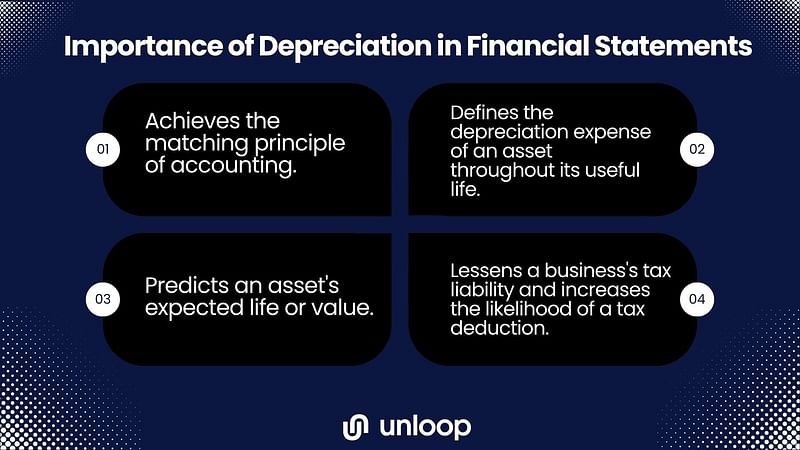
Calculating cumulative depreciation expense is an important task for any business. Depreciation does four things for a business and its financial statements:
Depreciating assets are a valuable accounting detail, especially for tax purposes. If you want to calculate depreciation accurately and make the most out of your company's investments, hire Unloop, one of the prime accounting services in the market.
Let's figure out what your assets’ worth. Book a free discovery call with us here.
Most capital used in starting a business goes into buying assets for the company. These assets are then used to generate income for the business. However, tangible assets tend to lose value over time and garner a hefty tax bill for a business expense, making it important to learn how to calculate depreciation.
In this article, we'll discuss depreciation, the four ways of calculating it, and the kind of assets you can expect to save money on.
Depreciation is when tangible assets a company invests in loses its value over time due to the typical wear-and-tear of products or equipment. It is an accounting term that determines what an asset is worth. Knowing an item's value is important for businesses to save money from depreciation expenses. It is also essential in monitoring your financial records.
Assets depreciate at different rates. For example, factory equipment may depreciate faster than a company car. There are different ways of calculating depreciation for both. Different factors like asset cost and salvage value come into play to determine the depreciation value of an asset.
Here are four methods to determine depreciation with their respective formulas.

The straight-line depreciation method is the most common form of calculating depreciation, and it's pretty straightforward. All you have to do is subtract the salvage value from the asset's cost and divide the difference using the asset's useful life in years. The company determines the salvage value, and should be a reasonable amount based on IRS rules.
If a business or organization wants to dispose of assets that lose value quicker, like a company car, the declining balance depreciation method is the best way to go. The declining and double-declining balance methods show assets that depreciate faster, so companies can get more value from depreciation deductions sooner.
To get the depreciation value for a declining balance, you have to multiply the beginning book value of an asset by the rate of depreciation. (To get the depreciation rate, divide 100% by the years of an asset's expected life.)
The same formula applies to the double declining balance method, except you double the amount of the book value. The double declining balance method is typically used to accelerate an asset's depreciation value for taxable income.
Machinery or equipment depreciates at a different rate than other assets because they are used constantly. Their production function defines how much these tools have been used. The method used for depreciating production units is called units of production depreciation.
To get units of production depreciation, follow the straight-line depreciation formula, except use an asset's useful life in hours instead of years.
The sum-of-the-year's digits method, also known as the accelerated depreciation method, is used to depreciate an asset without losing its value, allowing it to retain its value upon disposal. You can get a more even depreciation value over the years using the SYD method.
Getting the depreciation using the SYD method can be complicated. To calculate SYD, divide what's left of an asset's useful life by the sum of years. The SYD is an asset's productive life added together. For example, if an asset is expected to be useful for five years, you can get the SYD by adding 1+2+3+4+5.
Afterward, multiply the asset cost and salvage value. The answer will be your SYD for the first year. Calculating depreciation using the SYD method means having to do it yearly.
In accounting, not all business expenses carrying value are depreciable assets. Here are different kinds of assets in accounting and why or why not they are considered depreciable.
| Tangible Assets | Intangible Assets | Immaterial Assets |
Tangible assets are visible, physical objects and are the only type that can depreciate because they can lose value over time, unlike intangible assets. Some examples of tangible assets are company-owned buildings or houses, vehicles, and equipment.
Intangible assets cannot be seen or touched, like the value of a brand or image and an organization's intellectual property. Intangible assets cannot depreciate and are instead amortized. There are intangible assets that do not depreciate over time. For example, software created by the company will stay valuable since it cannot be destroyed and does not downgrade from use.
Intangible assets are not mentioned in the balance sheet unless they are acquired. For example, if an organization sells its brand image, that will naturally be included in the balance sheet. Certain expenses that contribute to an intangible asset can be credited to the balance sheet and added to an intangible asset's value.
Immaterial assets are tangible or intangible assets acquired for no more than 5% of the purchase price of the said asset. Immaterial assets are bought for a cost too little to be considered significant and can thus be included in miscellaneous or other expenses.

Calculating cumulative depreciation expense is an important task for any business. Depreciation does four things for a business and its financial statements:
Depreciating assets are a valuable accounting detail, especially for tax purposes. If you want to calculate depreciation accurately and make the most out of your company's investments, hire Unloop, one of the prime accounting services in the market.
Let's figure out what your assets’ worth. Book a free discovery call with us here.
Disclaimer: Please note this article is not financial advice. The purpose of our blog is purely educational, so please consult a professional accountant or financial advisor before making any financial decision.
Time-consuming, stressful, and tedious are often words associated with the manual bank reconciliation process. It is typical for businesses to do bank reconciliation every month. But other businesses choose to do them more frequently, so there are fewer transactions to check and a lesser possibility of errors and inconsistencies.
For businesses, bank reconciliations might be a hassle, but it doesn't have to be. Bank reconciliation software can speed up the process and make it easier for you. We'll discuss the automation process's benefits and give a quick overview of how to do it.
Automating the bank reconciliation process is not as challenging as it sounds. Don't forget to take notes! If you follow these simple setup processes, you'll worry less about bank reconciliation.
An automated process makes running a business more convenient. Investing in accounting software is a wise move for every business. However, other businesses, especially small ones, are reluctant to spend the money. If you're still in doubt, here are some of the advantages of automating your bank reconciliation process.
The manual reconciliation process is error-prone. No matter how careful business owners are, it is easy to misread figures and make mistakes in calculations and inputs. Not to mention, you have to go through tons of spreadsheets and documents to fix the errors. That is a significant amount of time that businesses could be using for other areas of their operations.
You can make sure everything is accurate down to the last detail with automatic reconciliation. Also, once a lapse is spotted, you will be notified so you can resolve it right away.
One of the excellent benefits of automated reconciliation is its time efficiency. With an accounting system, features that track outgoing cash, and the ability to match receipts to transactions, the reconciliation process can be completed in a matter of minutes compared to doing it manually, which can take hours.
Furthermore, you can skip combing through your spreadsheets for hours and hours. The accounting software can check the totals in the spreadsheet to see if they match your balance sheets, income statements, and other financial records.
You can achieve better cash flow management by automating your bank reconciliation process. The automatic process can quickly identify wrong and incomplete transactions, which can significantly affect a business's cash flow. Businesses can therefore decide how to manage their cash flow with confidence knowing exactly how much money they have available.
In addition, automatic bank reconciliation allows businesses to identify and resolve any outstanding issues on time, which can help them avoid late fees and other penalties that can negatively impact their cash flow. Overall, by improving the accuracy and efficiency of the reconciliation process, businesses can optimize their cash flow and improve their financial health.
Software with automatic bank reconciliation have fraud detection features that can help businesses identify early on if there are any unauthorized transactions or unusual activities that can indicate fraud. They can also alert businesses of missing or altered transactions that could be a sign of embezzlement.
With better fraud detection and prevention, businesses can protect their financial assets and maintain their integrity. When businesses detect fraud early, they can take swift action and prevent significant damage to the business. Further, automated bank reconciliations can make an audit trail for all your transactions, which is essential for investigating and resolving any fraudulent activities.

The benefits when businesses fully automate bank reconciliations go beyond the process. It can help business owners make more sound and crucial decisions. Here are some ways in which automated bank reconciliations help with decision-making.
Reconciling bank accounts is just one part of the entire accounting process. Many business owners, even seasoned ones, would prefer to avoid accounting altogether. Fortunately for entrepreneurs out there, Unloop offers the professional services you need.
We have a team of professionals that can handle all your accounting needs. Say goodbye to financial stress and hello to business growth! Experience our exceptional services, like bookkeeping, payroll, taxes, forecasting and more.
Book a call with our experts today, and see how we can help you!
Disclaimer: Please note this article is not financial advice. The purpose of our blog is purely educational, so please consult a professional accountant or financial advisor before making any financial decision.
Time-consuming, stressful, and tedious are often words associated with the manual bank reconciliation process. It is typical for businesses to do bank reconciliation every month. But other businesses choose to do them more frequently, so there are fewer transactions to check and a lesser possibility of errors and inconsistencies.
For businesses, bank reconciliations might be a hassle, but it doesn't have to be. Bank reconciliation software can speed up the process and make it easier for you. We'll discuss the automation process's benefits and give a quick overview of how to do it.
Automating the bank reconciliation process is not as challenging as it sounds. Don't forget to take notes! If you follow these simple setup processes, you'll worry less about bank reconciliation.
An automated process makes running a business more convenient. Investing in accounting software is a wise move for every business. However, other businesses, especially small ones, are reluctant to spend the money. If you're still in doubt, here are some of the advantages of automating your bank reconciliation process.
The manual reconciliation process is error-prone. No matter how careful business owners are, it is easy to misread figures and make mistakes in calculations and inputs. Not to mention, you have to go through tons of spreadsheets and documents to fix the errors. That is a significant amount of time that businesses could be using for other areas of their operations.
You can make sure everything is accurate down to the last detail with automatic reconciliation. Also, once a lapse is spotted, you will be notified so you can resolve it right away.
One of the excellent benefits of automated reconciliation is its time efficiency. With an accounting system, features that track outgoing cash, and the ability to match receipts to transactions, the reconciliation process can be completed in a matter of minutes compared to doing it manually, which can take hours.
Furthermore, you can skip combing through your spreadsheets for hours and hours. The accounting software can check the totals in the spreadsheet to see if they match your balance sheets, income statements, and other financial records.
You can achieve better cash flow management by automating your bank reconciliation process. The automatic process can quickly identify wrong and incomplete transactions, which can significantly affect a business's cash flow. Businesses can therefore decide how to manage their cash flow with confidence knowing exactly how much money they have available.
In addition, automatic bank reconciliation allows businesses to identify and resolve any outstanding issues on time, which can help them avoid late fees and other penalties that can negatively impact their cash flow. Overall, by improving the accuracy and efficiency of the reconciliation process, businesses can optimize their cash flow and improve their financial health.
Software with automatic bank reconciliation have fraud detection features that can help businesses identify early on if there are any unauthorized transactions or unusual activities that can indicate fraud. They can also alert businesses of missing or altered transactions that could be a sign of embezzlement.
With better fraud detection and prevention, businesses can protect their financial assets and maintain their integrity. When businesses detect fraud early, they can take swift action and prevent significant damage to the business. Further, automated bank reconciliations can make an audit trail for all your transactions, which is essential for investigating and resolving any fraudulent activities.

The benefits when businesses fully automate bank reconciliations go beyond the process. It can help business owners make more sound and crucial decisions. Here are some ways in which automated bank reconciliations help with decision-making.
Reconciling bank accounts is just one part of the entire accounting process. Many business owners, even seasoned ones, would prefer to avoid accounting altogether. Fortunately for entrepreneurs out there, Unloop offers the professional services you need.
We have a team of professionals that can handle all your accounting needs. Say goodbye to financial stress and hello to business growth! Experience our exceptional services, like bookkeeping, payroll, taxes, forecasting and more.
Book a call with our experts today, and see how we can help you!
With millions of customers and countless purchases, Amazon has been the go-to platform for eCommerce sellers. No surprise there. Curious about how they deal with taxes? The Amazon sales tax report for purchases is a document that details the taxes levied on Amazon transactions. And these reports do not go unchecked.
In this deep dive, we will unravel the complexities of this report, exploring some of the most important details it should contain. Let’s shed some light on the tax collection process and sales tax rates.
So, what are the details in an Amazon sales tax report? Here are some!
A sales tax is a consumption tax levied on goods and services. It is the kind of tax that should be collected from the final consumer of goods and services sold in a marketplace.
Sales tax rates vary depending on a country's sales tax law. There is no national sales tax law in the United States. Hence, there is no uniform rate, and it will depend on the state where you have nexus.
Unless you live in states or provinces that don't charge sales tax, a purchase will be subject to two kinds of sales tax: the state or federal tax rate and the local tax rate of the area to which it was sent. Some goods may be exempt from sales tax. For example, many governments generally exempt sales tax for necessary goods, like food, drinks, or groceries.
Not remitting sales tax or the wrong amount can get your business audited and fined. Therefore, staying on top of your sales tax is extremely important. With that, here are the tax rates for Canada and the US, respectively.
Canada has three tax types: General Sales Tax (GST), Provincial Sales Tax (PST), and Harmonized Sales Tax (HST). Quebec Sales Tax (QST) is a rate specifically charged for this province, while Retail Sales Tax (RST) is specifically applied in Manitoba.
Here are the rates for all sales taxes in Canada. You'll see these in the Amazon sales tax report. It pays to know the rates, as not all marketplaces handle sales tax calculation, collection, and remittances. Also, in case Amazon does not cover the other sales tax applied in a province, you’ll know.
| Province | GST | PST | HST | Total Tax to Pay |
| Alberta | 5% | 5% | ||
| Northwest Territories | 5% | 5% | ||
| Nunavut | 5% | 5% | ||
| Yukon | 5% | 5% | ||
| Saskatchewan | 5% | 6% | 11% | |
| British Columbia | 5% | 7% | 12% | |
| Manitoba | 5% | 12% | ||
| Ontario | 13% | 13% | ||
| Quebec | 5% | *9.975% | 14.98% | |
| New Brunswick | 15% | 15% | ||
| Newfoundland and Labrador | 15% | 15% | ||
| Nova Scotia | 15% | 15% | ||
| Prince Edward Island | 15% | 15% |
Source: Sales Tax Rates by Province, https://www.retailcouncil.org/resources/quick-facts/sales-tax-rates-by-province/
Sales Tax Rules Depend on the US State
The United States has 50 states, each with its own sales tax rates, rules, and regulations. Unlike Canada, where the package destination is the basis of the sales tax rate (unless stated otherwise), US states have different rules.
Some states base the rate on the package's source and others on the destination. Hence, aside from the different rates, check whether to apply the rate in the location of your business address or the rate of the state where your customer resides.
Here are the details of sales tax rates in America:
| State | State Rate | Range of Local Rates |
| Puerto Rico | 11.50% | 0% |
| California | 7.25% | 0% – 3.25% |
| Indiana | 7.00% | 0% |
| Mississippi | 7.00% | 0% – 1% |
| Rhode Island | 7.00% | 0% |
| Tennessee | 7.00% | 1.5% – 2.75% |
| Minnesota | 6.88% | 0% – 2% |
| Nevada | 6.85% | 0% – 1.525% |
| New Jersey | 6.63% | 0% |
| Arkansas | 6.50% | 0% – 6.125% |
| Kansas | 6.50% | 0% – 5.1% |
| Washington | 6.50% | 0.5% – 4.1% |
| Connecticut | 6.35% | 0% -1% |
| Illinois | 6.25% | 0% – 5.25% |
| Massachusetts | 6.25% | 0% |
| Texas | 6.25% | 0% – 2%1.75% local rate for remote sellers, 10-12/19 |
| District of Columbia | 6.00% | 0% |
| Florida | 6.00% | 0% – 2.5% |
| Idaho | 6.00% | 0% – 3% |
| Iowa | 6.00% | 0% – 2% |
| Kentucky | 6.00% | 0% |
| Maryland | 6.00% | 0% |
| Michigan | 6.00% | 0% |
| Pennsylvania | 6.00% | 0% – 2% |
| South Carolina | 6.00% | 0% – 3% |
| Vermont | 6.00% | 0% – 1% |
| West Virginia | 6.00% | 0% – 1% |
| Ohio | 5.75% | 0 – 2.25% |
| Arizona | 5.60% | 0 – 7.30% |
| Maine | 5.50% | 0% |
| Nebraska | 5.50% | 0% – 2.5% |
| New Mexico | 5.00% | 0.125% – 7.75% |
| North Dakota | 5.00% | 0% – 3% |
| Wisconsin | 5.00% | 0% – 1.75% |
| Utah | 4.85% | 1% – 7.5% |
| North Carolina | 4.75% | 2% – 3% |
| Oklahoma | 4.50% | 0% – 7% |
| Louisiana | 4.45% | 0% – 8.5% |
| Virginia | 4.30% | 1% – 2.7% |
| Missouri | 4.23% | 0.5% – 7.763% |
| South Dakota | 4.20% | 0% – 8% |
| Alabama | 4.00% | 0% – 9.0% |
| Georgia | 4.00% | 1% – 5% |
| Hawaii | 4.00% | 0% – 0.5% |
| New York | 4.00% | 0% – 5% |
| Wyoming | 4.00% | 0% – 4% |
| Colorado | 2.90% | 0% – 8.3% |
| Alaska | 0.00% | 0% – 9.5% |
| Delaware | 0.00% | 0% |
| Montana | 0.00% | 0% |
| New Hampshire | 0.00% | 0% |
| Oregon | 0.00% | 0% |
Sources:
US Range of Local Sales Tax Rates, https://www.salestaxinstitute.com/resources/rates
US States Sales Tax Rates, https://taxfoundation.org/publications/state-and-local-sales-tax-rates/

Knowing which products are taxable and which are not will help you understand sales tax reports. Only tax-levied products show up on these documents.
Most products are taxable; you must charge your customers' sales tax if you sell a taxable item. If you do business in several jurisdictions, especially when selling online, you must charge different sales tax rates depending on the state or province. To do this, you have to establish a sales tax nexus.
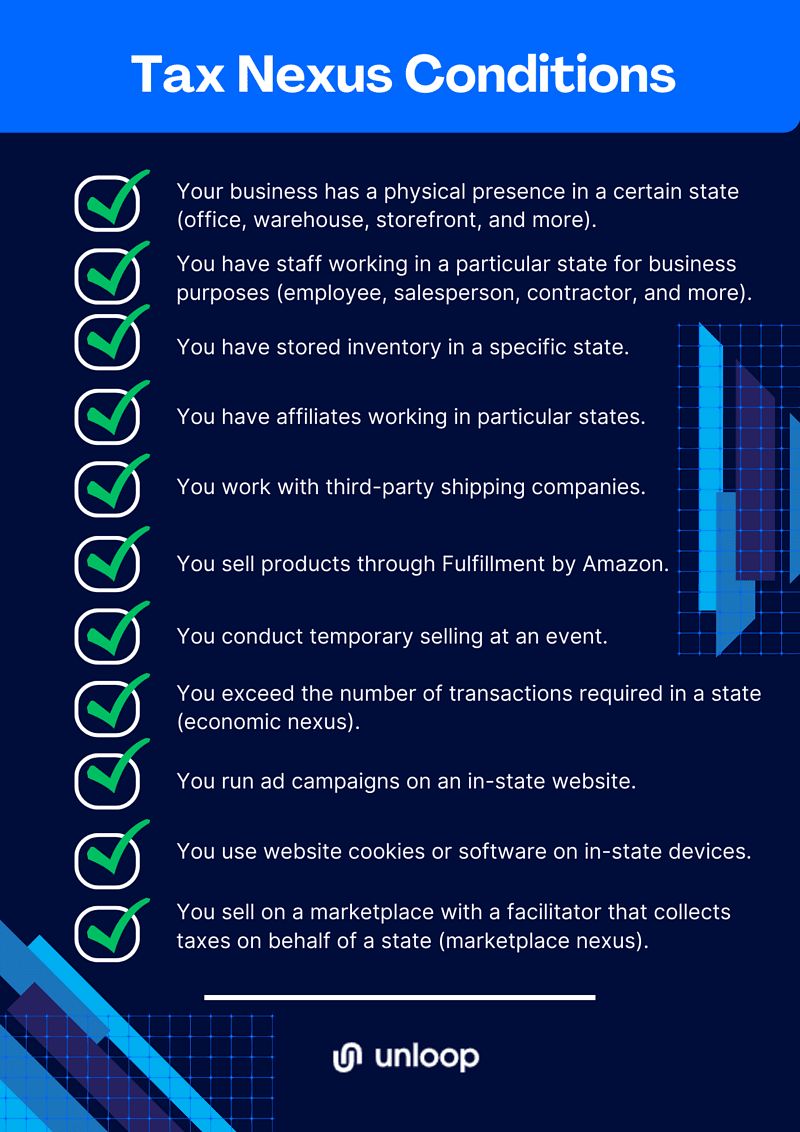
A sales tax nexus means your business has a “presence” in a particular jurisdiction. This presence subjects your business to that state's prevailing income and sales tax rules. For instance, if you sell products that need to be stored or shipped to a particular California, you must establish a nexus in that area and collect sales tax too.
Another way to establish a sales tax nexus is through intercompany transactions. For example, if you sell goods used by another company and delivered on behalf of its customers, you may be required to file taxes in that company's jurisdiction.
On the other hand, if you sell digital goods like music downloads, software subscriptions, or other intangible property, you don't need to report these transactions because they do not require storage space and physical delivery.
Aside from not having a nexus, another reason why some items won't be charged with sales taxes is because they are tax-exempt. No sales tax amount will be attributed to these purchases in the report.
Amazon has the Tax-Exempt Program that exempts individuals and groups from paying sales tax. To enjoy this benefit, your customers must submit complete tax information and documents on the Amazon platform.
In Canada, there are three basic instances when buyers can be tax-exempt:
Like in Canada, there are also tax-exempt individuals and groups in the US:
These clients must upload a tax-exempt certificate and other necessary documents to Amazon. Then, Amazon processes the documents through the platform’s Tax-Exempt Program.
After knowing the details in an Amazon sales tax report, let's check out some of your questions as a newbie seller. After going through these, you'll be ready to view your sales tax report and understand who's in charge and what happens during its calculation, collection, and remittance.
Yes, because of the Marketplace Facilitator (MPF) Law, which is unique to each state. This law cites that third-party sellers like Amazon should handle the collection, filing, and remittance of sales taxes.
Customers pay a one-time sales tax whenever they buy products and services on Amazon. The buyer will pay the sales tax for the purchased goods and services, and Amazon will only collect, calculate, and remit the sales tax.
The sales tax collection services provided by Amazon as a marketplace facilitator are free. The process is streamlined and requires minimal participation and input from the sellers—making it efficient for business.
There was a time when this law didn't cover Canada. Thankfully, MPF now applies to the country. Unless otherwise declared by specific provinces, Amazon will handle the collection, filing, and remittance of the sales taxes charged to your customers. All you have to do is track and ensure accuracy.

There are three main steps in filing taxes:
Let's check the steps one by one.
Before you can collect sales tax, you have to secure a permit. Without a permit, sales tax collection is illegal. You can find forms on your local revenue website and register your business.
Once you complete your registration, the tax collection agency will give your filing frequency. It can be monthly, quarterly, or annually, depending on your business's sales volume in a certain period.
After securing the permit, you can now legally collect sales tax. Amazon has a tax collection system that will handle collection for you once you input the correct settings. Tax charges may depend on whether the product sales are origin-based or destination-based.
Origin-based tax calculations mean that you follow the tax rate of where your business is located.
In comparison, destination-based calculations will consider the tax rate of where your products go, regardless of location.
Tax collection authorities will usually ask for sales tax reports and other business statements when you file for sales tax returns. You can easily find different reports in your Amazon Seller Central account. If you want comprehensive reports, you use accounting software to generate more detailed ones for your business. In addition, make sure that all the data in your tax returns are valid to avoid any issues and penalties.
Amazon sales tax reports are useful in helping sellers provide transparency to their customers. Although sales taxes are already handled on Amazon, they aren't the same as other platforms, so you must run them independently.
If you are wondering where to get such reports, you can do it through Amazon Seller Central Account Settings. To download any Amazon sales tax report, follow these steps:
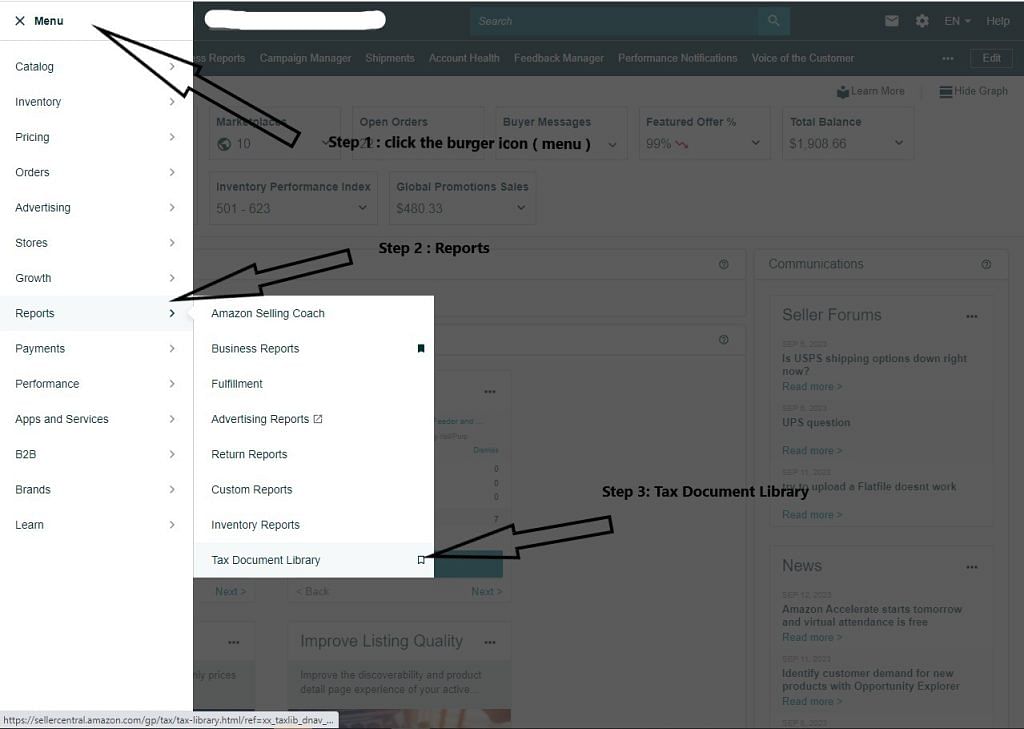
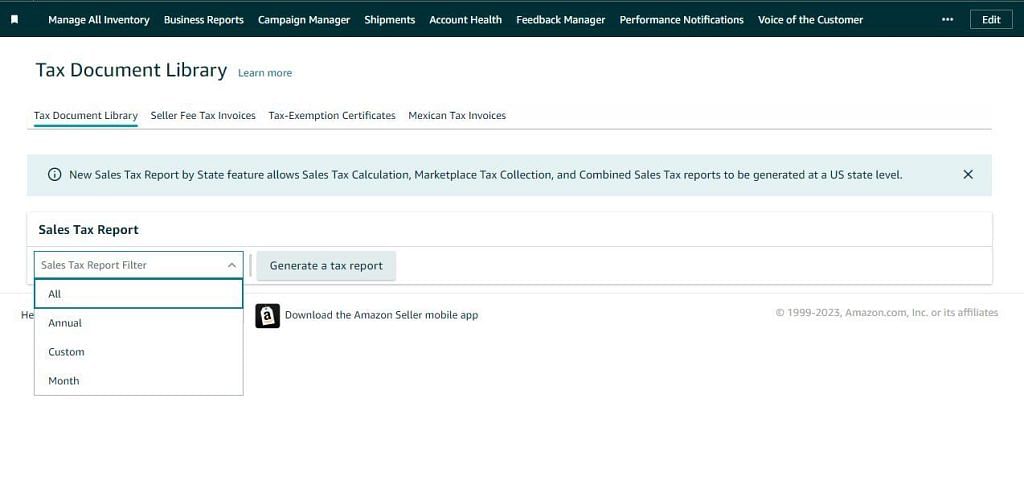
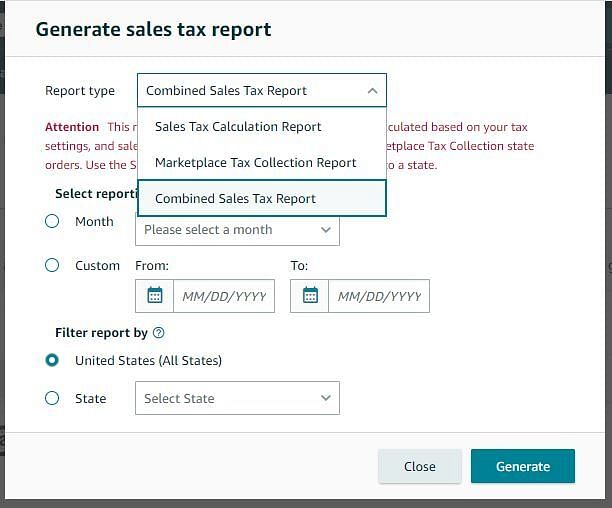
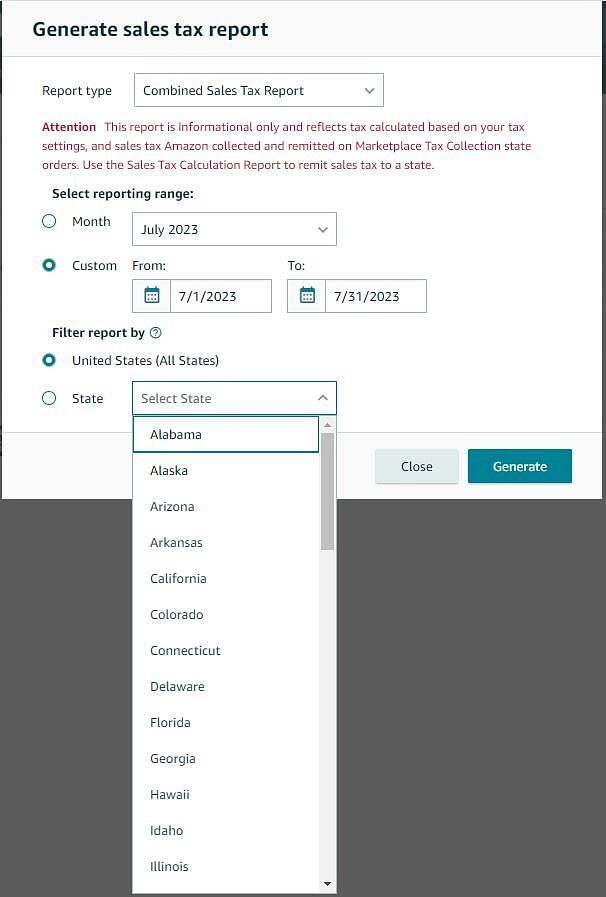
The Amazon sales tax report is a great way to help you stay compliant with relevant tax laws. You should also generate this report if you are responsible for collecting sales taxes, especially outside Amazon.
Are you still confused about sales taxes? Outsourcing tax support helps simplify running your ecommerce business.
Whatever ecommerce platform you use, adopting industry-specific tax and accounting methods is critical to achieving your business objectives. With the right accounting service, you can grasp these numbers and make more informed business decisions.
Unloop can be your partner as you grow your ecommerce business. Our team of experts can provide you with a wide range of services, from accounting to automating your sales tax collection and other important financial tasks.
Book a call with us, and we'll help you get started.
With millions of customers and countless purchases, Amazon has been the go-to platform for eCommerce sellers. No surprise there. Curious about how they deal with taxes? The Amazon sales tax report for purchases is a document that details the taxes levied on Amazon transactions. And these reports do not go unchecked.
In this deep dive, we will unravel the complexities of this report, exploring some of the most important details it should contain. Let’s shed some light on the tax collection process and sales tax rates.
So, what are the details in an Amazon sales tax report? Here are some!
A sales tax is a consumption tax levied on goods and services. It is the kind of tax that should be collected from the final consumer of goods and services sold in a marketplace.
Sales tax rates vary depending on a country's sales tax law. There is no national sales tax law in the United States. Hence, there is no uniform rate, and it will depend on the state where you have nexus.
Unless you live in states or provinces that don't charge sales tax, a purchase will be subject to two kinds of sales tax: the state or federal tax rate and the local tax rate of the area to which it was sent. Some goods may be exempt from sales tax. For example, many governments generally exempt sales tax for necessary goods, like food, drinks, or groceries.
Not remitting sales tax or the wrong amount can get your business audited and fined. Therefore, staying on top of your sales tax is extremely important. With that, here are the tax rates for Canada and the US, respectively.
Canada has three tax types: General Sales Tax (GST), Provincial Sales Tax (PST), and Harmonized Sales Tax (HST). Quebec Sales Tax (QST) is a rate specifically charged for this province, while Retail Sales Tax (RST) is specifically applied in Manitoba.
Here are the rates for all sales taxes in Canada. You'll see these in the Amazon sales tax report. It pays to know the rates, as not all marketplaces handle sales tax calculation, collection, and remittances. Also, in case Amazon does not cover the other sales tax applied in a province, you’ll know.
| Province | GST | PST | HST | Total Tax to Pay |
| Alberta | 5% | 5% | ||
| Northwest Territories | 5% | 5% | ||
| Nunavut | 5% | 5% | ||
| Yukon | 5% | 5% | ||
| Saskatchewan | 5% | 6% | 11% | |
| British Columbia | 5% | 7% | 12% | |
| Manitoba | 5% | 12% | ||
| Ontario | 13% | 13% | ||
| Quebec | 5% | *9.975% | 14.98% | |
| New Brunswick | 15% | 15% | ||
| Newfoundland and Labrador | 15% | 15% | ||
| Nova Scotia | 15% | 15% | ||
| Prince Edward Island | 15% | 15% |
Source: Sales Tax Rates by Province, https://www.retailcouncil.org/resources/quick-facts/sales-tax-rates-by-province/
Sales Tax Rules Depend on the US State
The United States has 50 states, each with its own sales tax rates, rules, and regulations. Unlike Canada, where the package destination is the basis of the sales tax rate (unless stated otherwise), US states have different rules.
Some states base the rate on the package's source and others on the destination. Hence, aside from the different rates, check whether to apply the rate in the location of your business address or the rate of the state where your customer resides.
Here are the details of sales tax rates in America:
| State | State Rate | Range of Local Rates |
| Puerto Rico | 11.50% | 0% |
| California | 7.25% | 0% – 3.25% |
| Indiana | 7.00% | 0% |
| Mississippi | 7.00% | 0% – 1% |
| Rhode Island | 7.00% | 0% |
| Tennessee | 7.00% | 1.5% – 2.75% |
| Minnesota | 6.88% | 0% – 2% |
| Nevada | 6.85% | 0% – 1.525% |
| New Jersey | 6.63% | 0% |
| Arkansas | 6.50% | 0% – 6.125% |
| Kansas | 6.50% | 0% – 5.1% |
| Washington | 6.50% | 0.5% – 4.1% |
| Connecticut | 6.35% | 0% -1% |
| Illinois | 6.25% | 0% – 5.25% |
| Massachusetts | 6.25% | 0% |
| Texas | 6.25% | 0% – 2%1.75% local rate for remote sellers, 10-12/19 |
| District of Columbia | 6.00% | 0% |
| Florida | 6.00% | 0% – 2.5% |
| Idaho | 6.00% | 0% – 3% |
| Iowa | 6.00% | 0% – 2% |
| Kentucky | 6.00% | 0% |
| Maryland | 6.00% | 0% |
| Michigan | 6.00% | 0% |
| Pennsylvania | 6.00% | 0% – 2% |
| South Carolina | 6.00% | 0% – 3% |
| Vermont | 6.00% | 0% – 1% |
| West Virginia | 6.00% | 0% – 1% |
| Ohio | 5.75% | 0 – 2.25% |
| Arizona | 5.60% | 0 – 7.30% |
| Maine | 5.50% | 0% |
| Nebraska | 5.50% | 0% – 2.5% |
| New Mexico | 5.00% | 0.125% – 7.75% |
| North Dakota | 5.00% | 0% – 3% |
| Wisconsin | 5.00% | 0% – 1.75% |
| Utah | 4.85% | 1% – 7.5% |
| North Carolina | 4.75% | 2% – 3% |
| Oklahoma | 4.50% | 0% – 7% |
| Louisiana | 4.45% | 0% – 8.5% |
| Virginia | 4.30% | 1% – 2.7% |
| Missouri | 4.23% | 0.5% – 7.763% |
| South Dakota | 4.20% | 0% – 8% |
| Alabama | 4.00% | 0% – 9.0% |
| Georgia | 4.00% | 1% – 5% |
| Hawaii | 4.00% | 0% – 0.5% |
| New York | 4.00% | 0% – 5% |
| Wyoming | 4.00% | 0% – 4% |
| Colorado | 2.90% | 0% – 8.3% |
| Alaska | 0.00% | 0% – 9.5% |
| Delaware | 0.00% | 0% |
| Montana | 0.00% | 0% |
| New Hampshire | 0.00% | 0% |
| Oregon | 0.00% | 0% |
Sources:
US Range of Local Sales Tax Rates, https://www.salestaxinstitute.com/resources/rates
US States Sales Tax Rates, https://taxfoundation.org/publications/state-and-local-sales-tax-rates/

Knowing which products are taxable and which are not will help you understand sales tax reports. Only tax-levied products show up on these documents.
Most products are taxable; you must charge your customers' sales tax if you sell a taxable item. If you do business in several jurisdictions, especially when selling online, you must charge different sales tax rates depending on the state or province. To do this, you have to establish a sales tax nexus.

A sales tax nexus means your business has a “presence” in a particular jurisdiction. This presence subjects your business to that state's prevailing income and sales tax rules. For instance, if you sell products that need to be stored or shipped to a particular California, you must establish a nexus in that area and collect sales tax too.
Another way to establish a sales tax nexus is through intercompany transactions. For example, if you sell goods used by another company and delivered on behalf of its customers, you may be required to file taxes in that company's jurisdiction.
On the other hand, if you sell digital goods like music downloads, software subscriptions, or other intangible property, you don't need to report these transactions because they do not require storage space and physical delivery.
Aside from not having a nexus, another reason why some items won't be charged with sales taxes is because they are tax-exempt. No sales tax amount will be attributed to these purchases in the report.
Amazon has the Tax-Exempt Program that exempts individuals and groups from paying sales tax. To enjoy this benefit, your customers must submit complete tax information and documents on the Amazon platform.
In Canada, there are three basic instances when buyers can be tax-exempt:
Like in Canada, there are also tax-exempt individuals and groups in the US:
These clients must upload a tax-exempt certificate and other necessary documents to Amazon. Then, Amazon processes the documents through the platform’s Tax-Exempt Program.
After knowing the details in an Amazon sales tax report, let's check out some of your questions as a newbie seller. After going through these, you'll be ready to view your sales tax report and understand who's in charge and what happens during its calculation, collection, and remittance.
Yes, because of the Marketplace Facilitator (MPF) Law, which is unique to each state. This law cites that third-party sellers like Amazon should handle the collection, filing, and remittance of sales taxes.
Customers pay a one-time sales tax whenever they buy products and services on Amazon. The buyer will pay the sales tax for the purchased goods and services, and Amazon will only collect, calculate, and remit the sales tax.
The sales tax collection services provided by Amazon as a marketplace facilitator are free. The process is streamlined and requires minimal participation and input from the sellers—making it efficient for business.
There was a time when this law didn't cover Canada. Thankfully, MPF now applies to the country. Unless otherwise declared by specific provinces, Amazon will handle the collection, filing, and remittance of the sales taxes charged to your customers. All you have to do is track and ensure accuracy.

There are three main steps in filing taxes:
Let's check the steps one by one.
Before you can collect sales tax, you have to secure a permit. Without a permit, sales tax collection is illegal. You can find forms on your local revenue website and register your business.
Once you complete your registration, the tax collection agency will give your filing frequency. It can be monthly, quarterly, or annually, depending on your business's sales volume in a certain period.
After securing the permit, you can now legally collect sales tax. Amazon has a tax collection system that will handle collection for you once you input the correct settings. Tax charges may depend on whether the product sales are origin-based or destination-based.
Origin-based tax calculations mean that you follow the tax rate of where your business is located.
In comparison, destination-based calculations will consider the tax rate of where your products go, regardless of location.
Tax collection authorities will usually ask for sales tax reports and other business statements when you file for sales tax returns. You can easily find different reports in your Amazon Seller Central account. If you want comprehensive reports, you use accounting software to generate more detailed ones for your business. In addition, make sure that all the data in your tax returns are valid to avoid any issues and penalties.
Amazon sales tax reports are useful in helping sellers provide transparency to their customers. Although sales taxes are already handled on Amazon, they aren't the same as other platforms, so you must run them independently.
If you are wondering where to get such reports, you can do it through Amazon Seller Central Account Settings. To download any Amazon sales tax report, follow these steps:




The Amazon sales tax report is a great way to help you stay compliant with relevant tax laws. You should also generate this report if you are responsible for collecting sales taxes, especially outside Amazon.
Are you still confused about sales taxes? Outsourcing tax support helps simplify running your ecommerce business.
Whatever ecommerce platform you use, adopting industry-specific tax and accounting methods is critical to achieving your business objectives. With the right accounting service, you can grasp these numbers and make more informed business decisions.
Unloop can be your partner as you grow your ecommerce business. Our team of experts can provide you with a wide range of services, from accounting to automating your sales tax collection and other important financial tasks.
Book a call with us, and we'll help you get started.
Disclaimer: Please note this article is not financial advice. The purpose of our blog is purely educational, so please consult a professional accountant or financial advisor before making any financial decision.
You're probably familiar with sales tax. It's that pesky thing you have to pay on most purchases, depending on your location. Many online sellers have asked themselves, "Do I need to collect sales tax for selling online?"
The answer is overwhelming, but it's not complicated as long as you have a tax guide like this one. Inside, we'll break down the basics of sales tax for online sellers and help clear up any confusion.
It's important for small business owners to be aware of their legal obligations. Fortunately, with a little knowledge about how tax law works, you can avoid many headaches by being compliant. We'll explain each part step by step so that by the time you finish this post, you'll be a bona fide sales tax expert. Let's get started!
Also known as ecommerce sales tax, internet sales tax is the small percentage you collect when you make an income from selling your product online. You must accurately assess sales taxes and pay them to the proper state tax authorities.
In the US, most states require online businesses to collect sales tax. On top of this, you need to check the cities and countries you sell in and see if they have special taxing districts, AKA special assessment districts.
Let's say your online business is currently located in Los Angeles, California.
| Los Angeles Tax Breakdown as of 2022 | |
| California | 6% |
| Los Angeles City | 0.25% |
| Los Angeles County Local Tax Sl. | 1% |
| Los Angeles County District Tax Sp. | 2.25% |
| Minimum Total of Sales Tax Rate | 9.5% |
As of 2022, the city of Los Angeles, California, requires businesses to pay a 9.6% tax rate from their sales and revenue. The final computation of your tax rate is determined by the exact location of your business.
The exact location of your business determines the taxes you have to file. You're responsible for charging the correct sales tax and remitting the right amount of tax rate back to your respective state. But what does this fancy term "sales tax nexus" even mean?

It's a legal term of the state that means "to be on the hook." If you have a place of business, it means you have a physical presence that the state can tax you on. It could be a:
Generally speaking, online businesses don't pay sales taxes if they don't have a nexus. But for many years, states have been arguing about not being able to collect sales taxes from online business owners simply because these marketplace sellers don't have enough sales within their located state to generate taxes.
But the burden shifted back to the seller since the US Supreme Court ruling over South Dakota v. Wayfair in June 2018. Sales tax nexus laws have changed on when and how to collect taxes. As a result, complying with tax prerequisites for online retailers, especially small to medium businesses, has gotten much messier.
The ruling changed how online businesses collect and charge sales taxes. Many states have the power to charge sales taxes on online businesses even without a nexus. But as of now, the status of this new tax law hasn't been passed as a federal law, which is good news for small businesses in some states.
Yes, you still need to collect sales taxes in different states if you have:
Most tangible property is taxable. But some states make tax exemptions for certain products.
Let's go back to California once more. If you are a marketplace seller that offers furniture, toys, and clothing, your products are subject to sales tax. In addition, some labor services and costs associated are even taxable if they are connected to producing new personal property.
But there are sales tax exemptions in California, such as:
Once you have learned that your business is taxable, you must take steps to ensure tax compliance. This means filing the appropriate tax forms and making sure that your tax liability is up to date. By taking the time to file for tax compliance, you can help protect your business and avoid costly penalties.
Don't skip this crucial step when collecting sales tax. Unfortunately, most states consider it illegal and penalize businesses that collect sales tax without a tax permit. So instead, we suggest you contact the Department of Revenue of your state to learn more about registering your business for sales tax collection.
Like each state's calculation of sales tax nexus, the state assigns how frequently you will file your sales tax—either monthly, quarterly, or annually. When your sales tax due date comes, it is your job to state how much you've collected.
Reporting your sales tax is easy if they want to see only the total of your sales tax collection. However, most states want to know how much you've collected in each county, city, state, and other special taxing districts in your nexus.

The verdict is in, and, as expected, the Supreme Court's decision in South Dakota v. Wayfair has had a massive impact on online sales tax laws across the US. As a result, states are now scrambling to put new rules and regulations governing how and when sellers must collect sales tax based on their customers' physical location.
Suppose you're an online seller doing business in more than one state. In that case, it's important to understand the implications of this ruling and take action to ensure you are compliant with all applicable sales tax laws.
Contact financial experts from Unloop today for help in navigating these murky waters and staying ahead of the curve for internet sales tax compliance.
Disclaimer: Please note this article is not financial advice. The purpose of our blog is purely educational, so please consult a professional accountant or financial advisor before making any financial decision.
You're probably familiar with sales tax. It's that pesky thing you have to pay on most purchases, depending on your location. Many online sellers have asked themselves, "Do I need to collect sales tax for selling online?"
The answer is overwhelming, but it's not complicated as long as you have a tax guide like this one. Inside, we'll break down the basics of sales tax for online sellers and help clear up any confusion.
It's important for small business owners to be aware of their legal obligations. Fortunately, with a little knowledge about how tax law works, you can avoid many headaches by being compliant. We'll explain each part step by step so that by the time you finish this post, you'll be a bona fide sales tax expert. Let's get started!
Also known as ecommerce sales tax, internet sales tax is the small percentage you collect when you make an income from selling your product online. You must accurately assess sales taxes and pay them to the proper state tax authorities.
In the US, most states require online businesses to collect sales tax. On top of this, you need to check the cities and countries you sell in and see if they have special taxing districts, AKA special assessment districts.
Let's say your online business is currently located in Los Angeles, California.
| Los Angeles Tax Breakdown as of 2022 | |
| California | 6% |
| Los Angeles City | 0.25% |
| Los Angeles County Local Tax Sl. | 1% |
| Los Angeles County District Tax Sp. | 2.25% |
| Minimum Total of Sales Tax Rate | 9.5% |
As of 2022, the city of Los Angeles, California, requires businesses to pay a 9.6% tax rate from their sales and revenue. The final computation of your tax rate is determined by the exact location of your business.
The exact location of your business determines the taxes you have to file. You're responsible for charging the correct sales tax and remitting the right amount of tax rate back to your respective state. But what does this fancy term "sales tax nexus" even mean?

It's a legal term of the state that means "to be on the hook." If you have a place of business, it means you have a physical presence that the state can tax you on. It could be a:
Generally speaking, online businesses don't pay sales taxes if they don't have a nexus. But for many years, states have been arguing about not being able to collect sales taxes from online business owners simply because these marketplace sellers don't have enough sales within their located state to generate taxes.
But the burden shifted back to the seller since the US Supreme Court ruling over South Dakota v. Wayfair in June 2018. Sales tax nexus laws have changed on when and how to collect taxes. As a result, complying with tax prerequisites for online retailers, especially small to medium businesses, has gotten much messier.
The ruling changed how online businesses collect and charge sales taxes. Many states have the power to charge sales taxes on online businesses even without a nexus. But as of now, the status of this new tax law hasn't been passed as a federal law, which is good news for small businesses in some states.
Yes, you still need to collect sales taxes in different states if you have:
Most tangible property is taxable. But some states make tax exemptions for certain products.
Let's go back to California once more. If you are a marketplace seller that offers furniture, toys, and clothing, your products are subject to sales tax. In addition, some labor services and costs associated are even taxable if they are connected to producing new personal property.
But there are sales tax exemptions in California, such as:
Once you have learned that your business is taxable, you must take steps to ensure tax compliance. This means filing the appropriate tax forms and making sure that your tax liability is up to date. By taking the time to file for tax compliance, you can help protect your business and avoid costly penalties.
Don't skip this crucial step when collecting sales tax. Unfortunately, most states consider it illegal and penalize businesses that collect sales tax without a tax permit. So instead, we suggest you contact the Department of Revenue of your state to learn more about registering your business for sales tax collection.
Like each state's calculation of sales tax nexus, the state assigns how frequently you will file your sales tax—either monthly, quarterly, or annually. When your sales tax due date comes, it is your job to state how much you've collected.
Reporting your sales tax is easy if they want to see only the total of your sales tax collection. However, most states want to know how much you've collected in each county, city, state, and other special taxing districts in your nexus.

The verdict is in, and, as expected, the Supreme Court's decision in South Dakota v. Wayfair has had a massive impact on online sales tax laws across the US. As a result, states are now scrambling to put new rules and regulations governing how and when sellers must collect sales tax based on their customers' physical location.
Suppose you're an online seller doing business in more than one state. In that case, it's important to understand the implications of this ruling and take action to ensure you are compliant with all applicable sales tax laws.
Contact financial experts from Unloop today for help in navigating these murky waters and staying ahead of the curve for internet sales tax compliance.
Dominating the FBA business goes beyond intuition—it demands data-driven insights, predictive analytics, and a strategic approach. Fortunately, FBA forecasting is not merely an option for sellers; it’s now necessary for business success.
From inventory management to sales, harnessing the power of forecasting can accurately predict future demand to ensure you are well-prepared to meet customer expectations while maintaining healthy stock levels.
This article provides an in-depth look at the relevance of forecasting on Amazon and the strategies you can use to grow your FBA business. Knowing the dynamics will help you steer your business to sustainable growth.
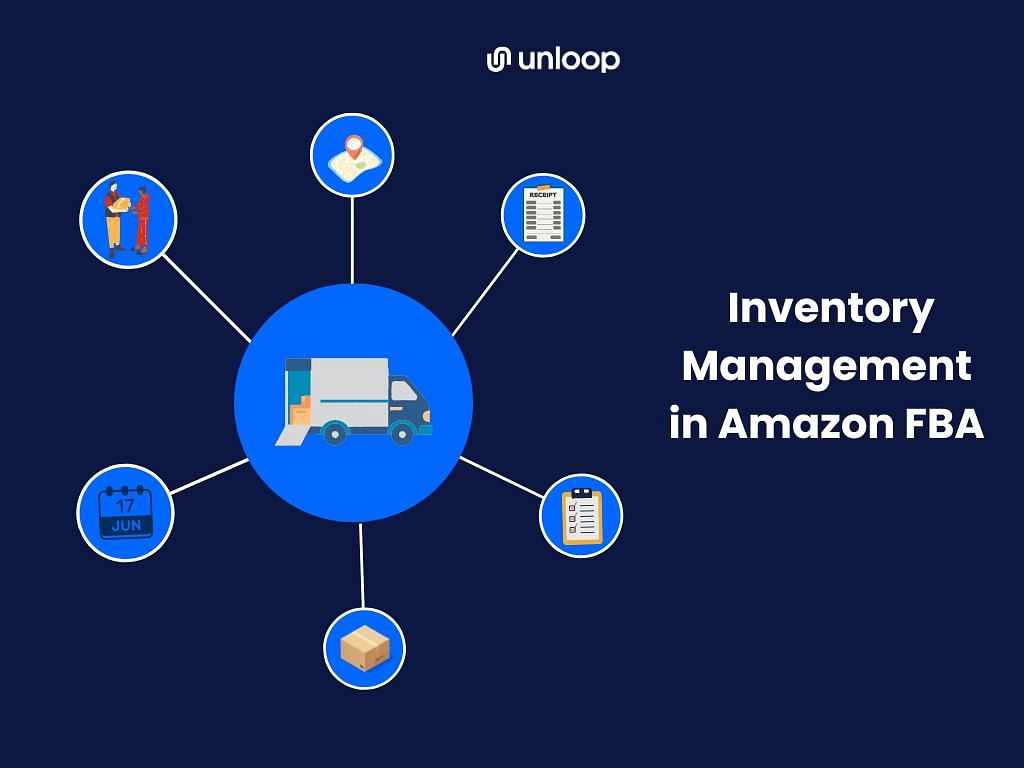
Amazon FBA, or "Fulfillment by Amazon," has transformed how sellers conduct ecommerce operations. This powerful service taps into Amazon's extensive network of warehouses and logistics infrastructure, allowing sellers to scale their businesses without the burden of managing complex logistics.
One critical area where forecasting can take center stage is FBA inventory management. As you entrust your products to fulfillment centers, you must plan and strategize your inventory to meet customer demands while optimizing costs and resources.
Let’s know more about its inventory role:
Inventory forecasting uses sales history, market trends, and pricing information to anticipate the future demands for a company’s products. By analyzing past sales patterns and external market factors, you can determine how much inventory to maintain, when to restock, and how to strengthen the supply chain.
You can get a clear picture of your current inventory status through inventory forecasting software. Its informed predictions help you identify if your business can fulfill its long-term and short-term obligations to Amazon FBA.
Unlike inventory forecasting, demand forecasting involves analyzing customer demand to envision future market needs. You can make strategic decisions about production, marketing, and resource allocation by assessing customer behavior.
With an accurate demand forecast, you can maintain the right inventory level, keep your supply chain running smoothly, and address any potential issues before they arise.
Running out of stock can severely impact your FBA business, resulting in lost sales and disappointed customers. A well-optimized inventory management system, fueled by accurate forecasting insights, minimizes the risk of stockouts, helping you maintain a consistent supply of products.
Sufficient inventory is vital, but over-ordering can lead to excess inventory and increased storage costs. This is where forecasting works. With this technique, you can review your past sales data, seasonal patterns, and other factors affecting your inventory planning. You can also avoid any surplus in the future.
Sales are the lifeblood of any Amazon FBA business. Without consistent sales, the entire FBA model would be rendered ineffective. As a seller leveraging FBA service, your primary goal is to present products that deeply resonate with customers, spurring high conversion rates.
Sales forecasting is the key to building a thriving enterprise in the marketplace. But how does it contribute to your transformation?
A precise sales forecast can establish meaningful KPIs (Key Performance Indicators), track your progress, and measure the success of your strategies. These important metrics and KPIs may include:
| Metrics and KPIs | |
| 📈 | Sales History: Evaluate your historical sales data to identify patterns and fluctuations in demand. |
| 🏆 | Sales Rank: Measure the performance of your product categories against competitors in the marketplace. |
| 📊 | Product Sales Forecasts: Estimate future sales based on historical data and sales trends. |
Advertising and social media are business components that improve demand forecast accuracy. By running ad campaigns on search engines like Google, you can generate data on customer engagement and behavior, which can be integrated into demand forecasting models.
Social media platforms also have much information on customer sentiment, interests, and feedback. From there, you can fine-tune your product line and promotional tactics.
3. Competitor Analysis
Even in the world of Amazon FBA, competition remains fierce. Sellers must navigate through various challenges to stand out and succeed. These challenges include: optimizing pricing strategies, enhancing product listings, and boosting product rankings to secure visibility.
Adding competitor analysis into your forecasting process boosts your knowledge of competitors' successful tactics. By benchmarking against industry peers, sellers can set realistic goals and determine where to outperform others, thus gaining a competitive advantage.
In order fulfillment, strong management is critical for maintaining a smooth and efficient supply chain. This process encompasses every step, from customer order to final delivery. It involves coordinating inventory levels, managing order fulfillment, and ensuring timely and accurate customer shipping.
Effective order management relies on data-driven insights and proactive planning, which can be achieved through forecasting. Let’s find out how forecasting functions in order management.
A purchase order (PO) is a legal document that outlines the items or services a buyer intends to purchase from a supplier. In the context of FBA forecasting, purchase orders play a significant role in managing inventory replenishment. Creating and tracking POs allow you to maintain accurate order records and negotiate favorable procurement terms with suppliers.
You can effectively take advantage of forecasting management if you pay close attention to the following:
| Purchase Orders | |
| 🛒 | Product Details: Include precise information about the items you order, such as SKU, quantity, and unit price. |
| 🚚 | Delivery Terms: Specify the terms, shipping method, and expected delivery date. |
| 💰 | Payment Terms: Agree upon the payment terms with your supplier, including the payment method and due date. |
Determining optimal order intervals and minimum order quantities (MOQ) is important for efficient inventory management. The order interval is the period between two consecutive purchase orders, while the MOQ is the lowest quantity of a product that a supplier agrees to sell.
Striking a balance between MOQ and order frequency can refine your purchasing costs and inventory carrying costs.
Service levels represent the percentage of orders that can be fulfilled upon customer request. High service levels signify substantial orders being fulfilled without delays or stockouts, leading to satisfied customers and positive experiences.
Monitoring service levels is an ongoing process, demanding continuous evaluation and adjustment. In this case, accurate forecasting is a reliable ally, alleviating stress and burden by furnishing invaluable insights into inventory management and order processing.
Product development in the Amazon FBA business focuses on introducing novel products or enhancing existing ones to cater to buyers’ preferences. Accurate forecasting equips sellers to make smarter decisions throughout the product development lifecycle.
Allow us to explore the workings of forecasting in this FBA area.
New products are essential for keeping your Amazon FBA store fresh and appealing to customers. But sometimes, it is prone to inherent uncertainties and risks. This is where forecasting becomes invaluable.
Before launching a new product, you can conduct market research on customer demand, competition, and potential sales opportunities. Making educated projections about the new product's potential success is also attainable.
By studying the performance of similar products in the market, you can gauge customer preferences, expect sales trends, and align your brand to meet those expectations.
Vendor relations thrive when sellers maximize forecasting to its fullest potential. By incorporating forecasting into their operations, they can cultivate strong and transparent relationships with their vendors, modifying various aspects of collaboration.
Forecasting allows sellers to communicate their demand and production requirements to vendors, boosting transparency and aligning expectations. This situation facilitates smoother procurement processes, as vendors can plan and allocate resources to meet the projected demand.
Forecasting also aids in negotiating favorable terms with vendors. Armed with projections of future sales and order volumes, you can get an advantage in negotiating pricing, knowing minimum order quantities, and getting lead times—all of which are useful in your overall profitability.
Financial planning in Amazon entails projecting future revenues, expenses, and cash flow to sustain business operations, particularly with the fees associated with selling on the platform.
Accurate forecasting is fundamental to effective financial planning, enabling strategic resource allocation, well-informed investment strategies, and a healthy financial position.
Delve into the intricate dynamics of forecasting within this specific area of Amazon FBA.
The right pricing strategy can directly impact sales, customer perception, and overall business performance. Setting prices too high may lead to limited sales and potential loss of customers to competitors, while pricing products too low may result in reduced profit margins.
Accurate pricing, guided by market research, competitor analysis, and data-driven insights, allows FBA sellers to position their products competitively, attract customers, and optimize revenue.
As cash flow refers to the movement of funds in and out of business, managing it efficiently ensures that FBA sellers have the necessary liquidity to cover expenses, invest in growth opportunities, and fulfill financial obligations promptly.
By accurately forecasting cash inflows and outflows, sellers can make better financial decisions, maintain financial stability, and seize possibilities for expansion and innovation.
Expense management involves assessing and diminishing costs across various areas, including inventory sourcing, storage fees, advertising, packaging, shipping, and operational expenses.
With forecasting, you know where to implement cost-saving measures, negotiate better terms with suppliers, and streamline operations.
Developing and refining your forecasting strategies means staying agile and responsive. A proactive approach to growth and anticipating market changes will be instrumental in cementing your brand's success in the competitive FBA world. Keep working at it with confidence and knowledge, and your business will have a higher chance of thriving.
If you are pressed for time or uncertain about handling data and numbers, fret not, for Unloop is here to lend a helping hand. We can help you project into the future and make quick, informed changes to manage your business outcomes.
As your business evolves, so do your future sales with the help of our comprehensive forecasting service. Book a discovery call now!
Dominating the FBA business goes beyond intuition—it demands data-driven insights, predictive analytics, and a strategic approach. Fortunately, FBA forecasting is not merely an option for sellers; it’s now necessary for business success.
From inventory management to sales, harnessing the power of forecasting can accurately predict future demand to ensure you are well-prepared to meet customer expectations while maintaining healthy stock levels.
This article provides an in-depth look at the relevance of forecasting on Amazon and the strategies you can use to grow your FBA business. Knowing the dynamics will help you steer your business to sustainable growth.

Amazon FBA, or "Fulfillment by Amazon," has transformed how sellers conduct ecommerce operations. This powerful service taps into Amazon's extensive network of warehouses and logistics infrastructure, allowing sellers to scale their businesses without the burden of managing complex logistics.
One critical area where forecasting can take center stage is FBA inventory management. As you entrust your products to fulfillment centers, you must plan and strategize your inventory to meet customer demands while optimizing costs and resources.
Let’s know more about its inventory role:
Inventory forecasting uses sales history, market trends, and pricing information to anticipate the future demands for a company’s products. By analyzing past sales patterns and external market factors, you can determine how much inventory to maintain, when to restock, and how to strengthen the supply chain.
You can get a clear picture of your current inventory status through inventory forecasting software. Its informed predictions help you identify if your business can fulfill its long-term and short-term obligations to Amazon FBA.
Unlike inventory forecasting, demand forecasting involves analyzing customer demand to envision future market needs. You can make strategic decisions about production, marketing, and resource allocation by assessing customer behavior.
With an accurate demand forecast, you can maintain the right inventory level, keep your supply chain running smoothly, and address any potential issues before they arise.
Running out of stock can severely impact your FBA business, resulting in lost sales and disappointed customers. A well-optimized inventory management system, fueled by accurate forecasting insights, minimizes the risk of stockouts, helping you maintain a consistent supply of products.
Sufficient inventory is vital, but over-ordering can lead to excess inventory and increased storage costs. This is where forecasting works. With this technique, you can review your past sales data, seasonal patterns, and other factors affecting your inventory planning. You can also avoid any surplus in the future.
Sales are the lifeblood of any Amazon FBA business. Without consistent sales, the entire FBA model would be rendered ineffective. As a seller leveraging FBA service, your primary goal is to present products that deeply resonate with customers, spurring high conversion rates.
Sales forecasting is the key to building a thriving enterprise in the marketplace. But how does it contribute to your transformation?
A precise sales forecast can establish meaningful KPIs (Key Performance Indicators), track your progress, and measure the success of your strategies. These important metrics and KPIs may include:
| Metrics and KPIs | |
| 📈 | Sales History: Evaluate your historical sales data to identify patterns and fluctuations in demand. |
| 🏆 | Sales Rank: Measure the performance of your product categories against competitors in the marketplace. |
| 📊 | Product Sales Forecasts: Estimate future sales based on historical data and sales trends. |
Advertising and social media are business components that improve demand forecast accuracy. By running ad campaigns on search engines like Google, you can generate data on customer engagement and behavior, which can be integrated into demand forecasting models.
Social media platforms also have much information on customer sentiment, interests, and feedback. From there, you can fine-tune your product line and promotional tactics.
3. Competitor Analysis
Even in the world of Amazon FBA, competition remains fierce. Sellers must navigate through various challenges to stand out and succeed. These challenges include: optimizing pricing strategies, enhancing product listings, and boosting product rankings to secure visibility.
Adding competitor analysis into your forecasting process boosts your knowledge of competitors' successful tactics. By benchmarking against industry peers, sellers can set realistic goals and determine where to outperform others, thus gaining a competitive advantage.
In order fulfillment, strong management is critical for maintaining a smooth and efficient supply chain. This process encompasses every step, from customer order to final delivery. It involves coordinating inventory levels, managing order fulfillment, and ensuring timely and accurate customer shipping.
Effective order management relies on data-driven insights and proactive planning, which can be achieved through forecasting. Let’s find out how forecasting functions in order management.
A purchase order (PO) is a legal document that outlines the items or services a buyer intends to purchase from a supplier. In the context of FBA forecasting, purchase orders play a significant role in managing inventory replenishment. Creating and tracking POs allow you to maintain accurate order records and negotiate favorable procurement terms with suppliers.
You can effectively take advantage of forecasting management if you pay close attention to the following:
| Purchase Orders | |
| 🛒 | Product Details: Include precise information about the items you order, such as SKU, quantity, and unit price. |
| 🚚 | Delivery Terms: Specify the terms, shipping method, and expected delivery date. |
| 💰 | Payment Terms: Agree upon the payment terms with your supplier, including the payment method and due date. |
Determining optimal order intervals and minimum order quantities (MOQ) is important for efficient inventory management. The order interval is the period between two consecutive purchase orders, while the MOQ is the lowest quantity of a product that a supplier agrees to sell.
Striking a balance between MOQ and order frequency can refine your purchasing costs and inventory carrying costs.
Service levels represent the percentage of orders that can be fulfilled upon customer request. High service levels signify substantial orders being fulfilled without delays or stockouts, leading to satisfied customers and positive experiences.
Monitoring service levels is an ongoing process, demanding continuous evaluation and adjustment. In this case, accurate forecasting is a reliable ally, alleviating stress and burden by furnishing invaluable insights into inventory management and order processing.
Product development in the Amazon FBA business focuses on introducing novel products or enhancing existing ones to cater to buyers’ preferences. Accurate forecasting equips sellers to make smarter decisions throughout the product development lifecycle.
Allow us to explore the workings of forecasting in this FBA area.
New products are essential for keeping your Amazon FBA store fresh and appealing to customers. But sometimes, it is prone to inherent uncertainties and risks. This is where forecasting becomes invaluable.
Before launching a new product, you can conduct market research on customer demand, competition, and potential sales opportunities. Making educated projections about the new product's potential success is also attainable.
By studying the performance of similar products in the market, you can gauge customer preferences, expect sales trends, and align your brand to meet those expectations.
Vendor relations thrive when sellers maximize forecasting to its fullest potential. By incorporating forecasting into their operations, they can cultivate strong and transparent relationships with their vendors, modifying various aspects of collaboration.
Forecasting allows sellers to communicate their demand and production requirements to vendors, boosting transparency and aligning expectations. This situation facilitates smoother procurement processes, as vendors can plan and allocate resources to meet the projected demand.
Forecasting also aids in negotiating favorable terms with vendors. Armed with projections of future sales and order volumes, you can get an advantage in negotiating pricing, knowing minimum order quantities, and getting lead times—all of which are useful in your overall profitability.
Financial planning in Amazon entails projecting future revenues, expenses, and cash flow to sustain business operations, particularly with the fees associated with selling on the platform.
Accurate forecasting is fundamental to effective financial planning, enabling strategic resource allocation, well-informed investment strategies, and a healthy financial position.
Delve into the intricate dynamics of forecasting within this specific area of Amazon FBA.
The right pricing strategy can directly impact sales, customer perception, and overall business performance. Setting prices too high may lead to limited sales and potential loss of customers to competitors, while pricing products too low may result in reduced profit margins.
Accurate pricing, guided by market research, competitor analysis, and data-driven insights, allows FBA sellers to position their products competitively, attract customers, and optimize revenue.
As cash flow refers to the movement of funds in and out of business, managing it efficiently ensures that FBA sellers have the necessary liquidity to cover expenses, invest in growth opportunities, and fulfill financial obligations promptly.
By accurately forecasting cash inflows and outflows, sellers can make better financial decisions, maintain financial stability, and seize possibilities for expansion and innovation.
Expense management involves assessing and diminishing costs across various areas, including inventory sourcing, storage fees, advertising, packaging, shipping, and operational expenses.
With forecasting, you know where to implement cost-saving measures, negotiate better terms with suppliers, and streamline operations.
Developing and refining your forecasting strategies means staying agile and responsive. A proactive approach to growth and anticipating market changes will be instrumental in cementing your brand's success in the competitive FBA world. Keep working at it with confidence and knowledge, and your business will have a higher chance of thriving.
If you are pressed for time or uncertain about handling data and numbers, fret not, for Unloop is here to lend a helping hand. We can help you project into the future and make quick, informed changes to manage your business outcomes.
As your business evolves, so do your future sales with the help of our comprehensive forecasting service. Book a discovery call now!
Outsourcing tasks for different business areas can be beneficial, especially when you're not well-versed in doing such things. When it comes to finances, you can get a bookkeeper or an accountant to help you. But what’s the difference between bookkeeping and accounting in the first place?
You've come to the right place if you're considering hiring either of the two (or both). We'll list the different responsibilities of bookkeepers and accountants so you can hire the proper help for your growing business.
Since they both involve managing a company's financial position, many use the terms bookkeeping and accounting interchangeably. However, they are vastly different.
Bookkeeping focuses on collecting, filing, and recording financial transactions. Bookkeepers focus on keeping things organized while accurately recording these business transactions.
The discipline of bookkeeping follows this cycle when recording business transactions.
There are two ways to do bookkeeping: single-entry and double-entry bookkeeping.
In the simplest sense, bookkeeping for startups means jotting down expenses and evening them out at the end of the week with the sales. This type of bookkeeping is called single-entry bookkeeping, which tracks only how much money goes in and out of the company without diving into the specifics.
While acceptable for small business owners, single-entry bookkeeping can leave much room for error, especially in financial reports. Since it lacks data, single-entry bookkeeping cannot produce a balance sheet. It will also be difficult to do taxes since the IRS does not allow single-entry bookkeeping to be used as a record for tax returns.
Compared to the previous type, double-entry bookkeeping is much more complicated. However, it can give you much more accurate financial reports. In double-entry bookkeeping, transactions are entered twice: once each for different accounting tools, debit and credit.
For example, if you make a loan, single-entry bookkeeping will label it as income. However, the interest attached to that loan will also become an expense.
On the other hand, if you enter a loan in double-entry bookkeeping, the system will label it as a debit, which is a liability more than an asset.
Double-entry bookkeeping can provide business owners with much more accurate reports and, since it logs debit and credit, can also provide a company with a balance sheet.
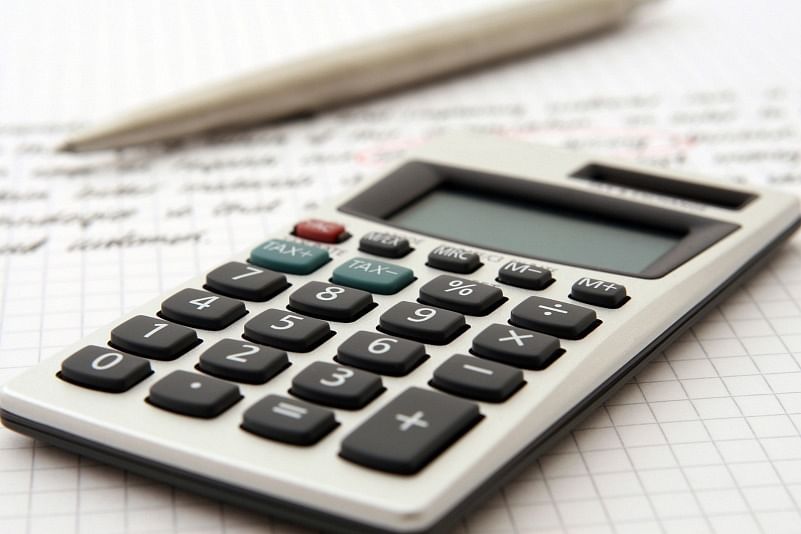
Accounting aims to evaluate financial information for a company or organization. It is about having an overall look at the business's financial data and interpreting that data to create sound decisions, such as acquiring business loans and expanding the business.
Accountants are more focused on understanding and analyzing the provided financial data. They provide consultations based on said data and are tasked to give out advice regarding financial decisions in business operations.
There are several subdisciplines under accounting, some of them are:
Accounting can be performed in two ways, depending on the company's financial situation.
Cash-basis accounting is a type of accounting that bases the business's current financial position on its immediate transactions. In cash-basis accounting, accountants record how much money goes directly into a business and how much they spend on expenses and figure out their net profit.
When accounting on a cash basis, accountants don't include delayed payments as part of the company's cash flow, making this method more limited than accrual accounting.
On the other hand, accrual accounting is a type of accounting that accounts for all assets and liabilities of a company. In this type of accounting, sales that have not been fulfilled yet are also included in the cash flow while also keeping track of expenses that have not yet been fulfilled.
With accrual accounting, business owners are given the whole picture of their company's financial situation. And with fulfilled and unfulfilled payments in their company's financial data, they can make long-term plans for their financial transactions and better understand their company's overall financial health.
Here are a few examples of accruals.
| Accrued Revenues | Accrued revenue is the money companies are expected to receive even before payment. Once revenue has been earned, a company’s accounting considers it the company’s money. |
| Deferred Revenues | Deferred revenue is the money a company receives for goods or services even before they have fulfilled their client’s demands. When a business makes deferred revenues, the amount is postponed from being included in a company’s revenue until the client’s demands have been met. |
| Accrued Income | Accrued income is the profit earned before payment. Unlike accrued revenue, accrued income is a company’s net profit. Accounting for accrued income does not include expenses attached to the sale of the goods or services that provided the income. |
| Accrued Expenses | Accrued expenses is the amount of money a company owes. When companies make loans or make purchases with long-term payment schedules, they log these expenses regardless of whether or not they fit the same accounting period. |
| Accounts Receivable | Accounts receivable is the amount of money a company expects to be paid. Invoices have already been sent for the money in accounts receivable, giving the company a concrete timeframe of when they expect to get the money. |
| Accounts Payable | Accounts payable is the amount of money a company owes to other people or businesses when they make purchases from them (in the form of goods or services). |

Hiring a trained professional to help you manage your business means allocating resources to pay them. But, of course, you want your hard-earned money to be worthy of the service you are getting.
So let's look at the different responsibilities of accountants and bookkeepers to help you further differentiate bookkeeping and accounting tasks.
Although they don’t necessarily need an accounting degree to perform the job, most people prefer hiring bookkeepers who have finished an associate’s or bachelor’s degree related to accounting or business.
Bookkeepers are trained and do not need state-mandated exams and certifications to do their job. On average, a bookkeeper's rate starts at $30 per hour.
Whether cash flow comes in plenty or slows down, tracking everything that comes in and out of your business is a way of telling if your business is doing well. Part of a bookkeeper's job is recording weekly business sales and expense transactions.
Because of modern technology, automated bookkeeping software is now available, making it easier for bookkeepers to record your data. Moreover, bookkeeping software instantly summarizes your transactions whether you want monthly, quarterly, or annual data.
It's common for small businesses to have suppliers instead of producing their own goods. Of course, you need to pay the suppliers for the goods they manufacture for you. You can work with several suppliers if your company sells various goods.
The bookkeeper must make payments to your suppliers. They can also make payments on behalf of your business for other necessary expenses.
In addition, as they make payments for your business, they are in charge of the collection. They send invoices to your clients to ensure all payments are made on time. They also record if payments and receivables come in late to ensure that your sheets remain balanced.
A bookkeeper's service may vary, and it can include processing payroll. For small businesses, bookkeepers can perform some duties of the HR department. For example, they can assist in processing paychecks and ensure employees get their pay accurately and on time.
Bookkeepers also reconcile accounts to maintain a company's financial integrity. They are well-equipped in identifying and finding errors in the books they maintain. Reconciling your accounts can fish out any inconsistencies in your company's accounting, which could single out any fraud or theft attempts within your business.
Businesses produce several financial statements. The data on these statements can tell if your business is stable or on the verge of failing. These statements are then given to licensed accountants to review and analyze.
Balance sheets, cash flow statements, income statements, and statements of equity are a few crucial financial documents that bookkeepers can produce.
A certified public accountant goes through a rigorous accounting degree and must pass state-mandated licensure examinations before offering services. A certified accountant's average rate is between $50–$100. It can go higher depending on their work experience.
The accountant's role is to ensure all data in the business's financial records are valid and accurate. Accountants are responsible for tracking any statement inconsistencies and pinpointing any problems. They will also be in charge of consulting with a bookkeeper when they see these inconsistencies.
Once everything is verified, accountants will be the ones to answer if auditors check on your business. They also present these statements to stakeholders and potential investors to help grow your business.
If bookkeepers record the cash flow in a business, the accountant makes sure you pay up correctly—especially taxes. Taxation is an important part of business, and you must comply with tax laws to run your business legally and smoothly.
Accountants file all tax returns for your business. Tax filing is done quarterly or annually, depending on the rule of your country's tax collection agency. Accountants ensure you file and declare taxes on time so you won't have to pay fines and other unnecessary expenses.
An accountant can examine your business's financial records to forecast your business's future. Besides records, there are other ways accountants can predict the direction of your business.
For example, the market research method uses how many people are potential buyers when a product is launched. This information can help you significantly enhance your sales.
Other forecasting methods may include factors like GDP, economic factors, trending, and data models, which can be used for long-term forecasts. Accountants can also help you plan your business's next step. Risk assessment lets you see if your actions will benefit your business growth.
Many small business owners tend to go big and be reckless with their decisions, causing failure. Accountants will be able to strategize with you along the way so your business resources won't go to waste. Their financial advice will help you allocate your resources to the right department.
Small businesses strive to make their processes more efficient to lessen their expenses. Budgeting within the business process is also in the job description of an accountant. They can pinpoint your business areas with unnecessary expenses that they think you can lessen.
Accountants can help you save money and allocate them to the other areas of your business you can improve.
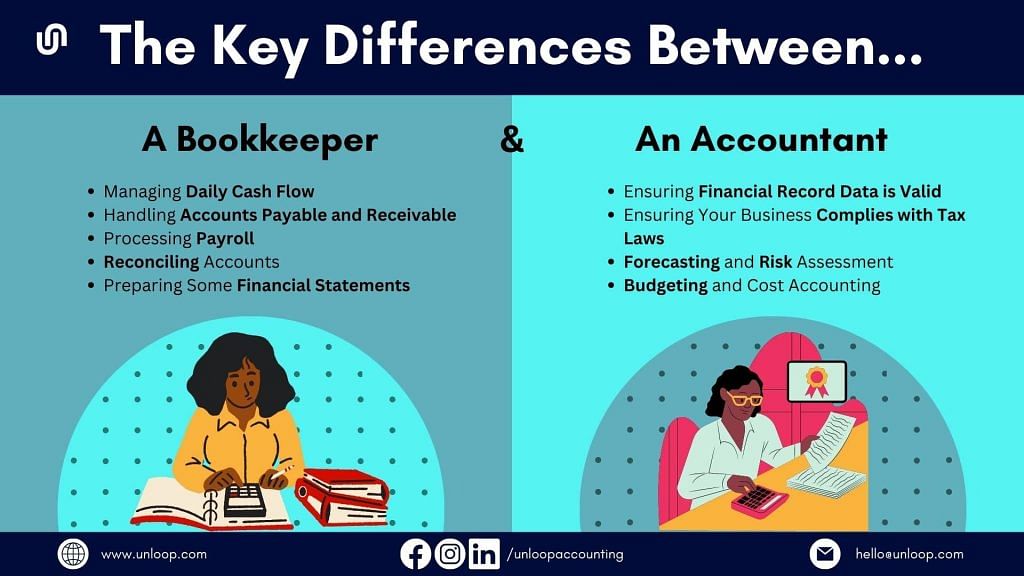
As mentioned, modern technology has made accounting and bookkeeping easier. If you aren’t fond of letting other people handle the work, looking for affordable accounting and bookkeeping software with easy-to-use features is ideal.
These tools may vary according to their uses and features. Choosing the one most suited to your business is crucial.
This software is best for small businesses because it is affordable and, at the same time, effective. One of the best things about QuickBooks is its tools for different accounting tasks, such as creating professional invoices, taking payments, keeping tabs on expenses, and monitoring your cash flow.
Besides these, what makes QuickBooks attractive is its scalability. You can adjust your plan according to your business's size and needs. It is recommended for small businesses that wish to expand later on.
Another great choice of accounting software for small business owners is NetSuite because of its variety of features, including enterprise resource planning tools. Its automation makes it simple for businesses to collect and send invoices and get a clear picture of how they are doing financially.
FreshBooks is one of the best choices for those who still can't afford expensive plans. Despite its affordable price, this software is an all-in-one accounting solution that can provide essential bookkeeping services for your business.
FreshBooks also boasts easy-to-use features, which benefit those who don't have a background in accounting. FreshBooks is recommended for freelancers and new business owners.
This simple accounting software is best for microbusinesses with its basic features and affordability, allowing businesses to grow without spending big on accounting software programs. Its basic features include tax services and generating financial reports.
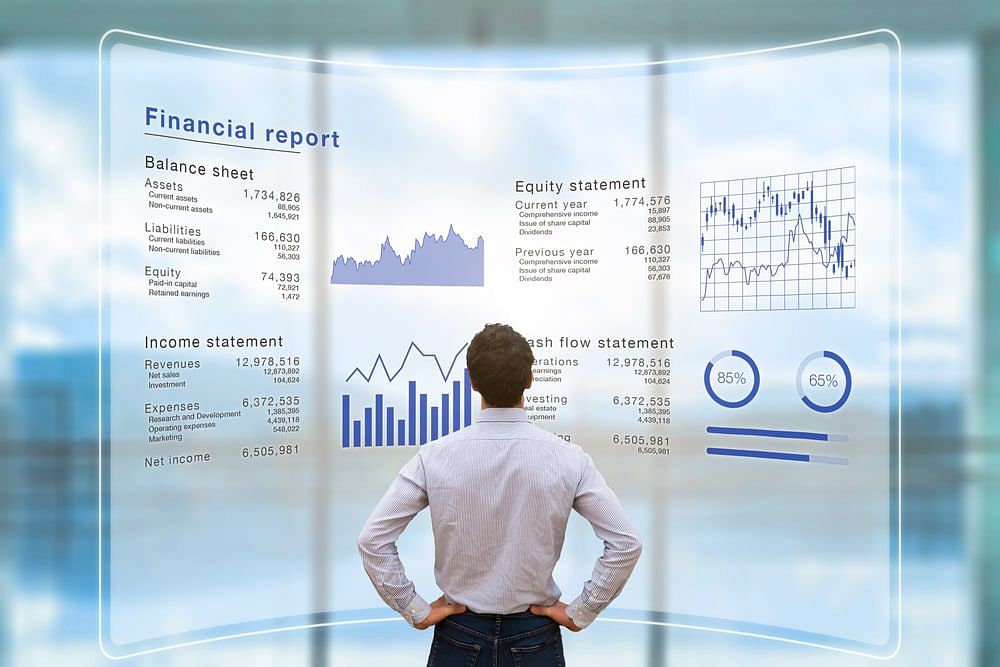
The difference between accounting and bookkeeping may be hard to spot as they both focus on the financial aspect of the business. To simplify, bookkeepers keep all financial transactions in an organized record. In comparison, accountants are the ones to analyze and interpret the data.
So which one is better for a small business? As you start, bookkeeping will be easier for you to handle. The accounting process can be a little trickier but still manageable. However, hiring both may be a good decision as your business grows and more cash flows into your company. For trusted bookkeepers and professional partnered accountants, book a call with Unloop at +1 877-421-7270 and talk to our professionals. We offer many different financial services to fit a small business's budget.
Outsourcing tasks for different business areas can be beneficial, especially when you're not well-versed in doing such things. When it comes to finances, you can get a bookkeeper or an accountant to help you. But what’s the difference between bookkeeping and accounting in the first place?
You've come to the right place if you're considering hiring either of the two (or both). We'll list the different responsibilities of bookkeepers and accountants so you can hire the proper help for your growing business.
Since they both involve managing a company's financial position, many use the terms bookkeeping and accounting interchangeably. However, they are vastly different.
Bookkeeping focuses on collecting, filing, and recording financial transactions. Bookkeepers focus on keeping things organized while accurately recording these business transactions.
The discipline of bookkeeping follows this cycle when recording business transactions.
There are two ways to do bookkeeping: single-entry and double-entry bookkeeping.
In the simplest sense, bookkeeping for startups means jotting down expenses and evening them out at the end of the week with the sales. This type of bookkeeping is called single-entry bookkeeping, which tracks only how much money goes in and out of the company without diving into the specifics.
While acceptable for small business owners, single-entry bookkeeping can leave much room for error, especially in financial reports. Since it lacks data, single-entry bookkeeping cannot produce a balance sheet. It will also be difficult to do taxes since the IRS does not allow single-entry bookkeeping to be used as a record for tax returns.
Compared to the previous type, double-entry bookkeeping is much more complicated. However, it can give you much more accurate financial reports. In double-entry bookkeeping, transactions are entered twice: once each for different accounting tools, debit and credit.
For example, if you make a loan, single-entry bookkeeping will label it as income. However, the interest attached to that loan will also become an expense.
On the other hand, if you enter a loan in double-entry bookkeeping, the system will label it as a debit, which is a liability more than an asset.
Double-entry bookkeeping can provide business owners with much more accurate reports and, since it logs debit and credit, can also provide a company with a balance sheet.

Accounting aims to evaluate financial information for a company or organization. It is about having an overall look at the business's financial data and interpreting that data to create sound decisions, such as acquiring business loans and expanding the business.
Accountants are more focused on understanding and analyzing the provided financial data. They provide consultations based on said data and are tasked to give out advice regarding financial decisions in business operations.
There are several subdisciplines under accounting, some of them are:
Accounting can be performed in two ways, depending on the company's financial situation.
Cash-basis accounting is a type of accounting that bases the business's current financial position on its immediate transactions. In cash-basis accounting, accountants record how much money goes directly into a business and how much they spend on expenses and figure out their net profit.
When accounting on a cash basis, accountants don't include delayed payments as part of the company's cash flow, making this method more limited than accrual accounting.
On the other hand, accrual accounting is a type of accounting that accounts for all assets and liabilities of a company. In this type of accounting, sales that have not been fulfilled yet are also included in the cash flow while also keeping track of expenses that have not yet been fulfilled.
With accrual accounting, business owners are given the whole picture of their company's financial situation. And with fulfilled and unfulfilled payments in their company's financial data, they can make long-term plans for their financial transactions and better understand their company's overall financial health.
Here are a few examples of accruals.
| Accrued Revenues | Accrued revenue is the money companies are expected to receive even before payment. Once revenue has been earned, a company’s accounting considers it the company’s money. |
| Deferred Revenues | Deferred revenue is the money a company receives for goods or services even before they have fulfilled their client’s demands. When a business makes deferred revenues, the amount is postponed from being included in a company’s revenue until the client’s demands have been met. |
| Accrued Income | Accrued income is the profit earned before payment. Unlike accrued revenue, accrued income is a company’s net profit. Accounting for accrued income does not include expenses attached to the sale of the goods or services that provided the income. |
| Accrued Expenses | Accrued expenses is the amount of money a company owes. When companies make loans or make purchases with long-term payment schedules, they log these expenses regardless of whether or not they fit the same accounting period. |
| Accounts Receivable | Accounts receivable is the amount of money a company expects to be paid. Invoices have already been sent for the money in accounts receivable, giving the company a concrete timeframe of when they expect to get the money. |
| Accounts Payable | Accounts payable is the amount of money a company owes to other people or businesses when they make purchases from them (in the form of goods or services). |

Hiring a trained professional to help you manage your business means allocating resources to pay them. But, of course, you want your hard-earned money to be worthy of the service you are getting.
So let's look at the different responsibilities of accountants and bookkeepers to help you further differentiate bookkeeping and accounting tasks.
Although they don’t necessarily need an accounting degree to perform the job, most people prefer hiring bookkeepers who have finished an associate’s or bachelor’s degree related to accounting or business.
Bookkeepers are trained and do not need state-mandated exams and certifications to do their job. On average, a bookkeeper's rate starts at $30 per hour.
Whether cash flow comes in plenty or slows down, tracking everything that comes in and out of your business is a way of telling if your business is doing well. Part of a bookkeeper's job is recording weekly business sales and expense transactions.
Because of modern technology, automated bookkeeping software is now available, making it easier for bookkeepers to record your data. Moreover, bookkeeping software instantly summarizes your transactions whether you want monthly, quarterly, or annual data.
It's common for small businesses to have suppliers instead of producing their own goods. Of course, you need to pay the suppliers for the goods they manufacture for you. You can work with several suppliers if your company sells various goods.
The bookkeeper must make payments to your suppliers. They can also make payments on behalf of your business for other necessary expenses.
In addition, as they make payments for your business, they are in charge of the collection. They send invoices to your clients to ensure all payments are made on time. They also record if payments and receivables come in late to ensure that your sheets remain balanced.
A bookkeeper's service may vary, and it can include processing payroll. For small businesses, bookkeepers can perform some duties of the HR department. For example, they can assist in processing paychecks and ensure employees get their pay accurately and on time.
Bookkeepers also reconcile accounts to maintain a company's financial integrity. They are well-equipped in identifying and finding errors in the books they maintain. Reconciling your accounts can fish out any inconsistencies in your company's accounting, which could single out any fraud or theft attempts within your business.
Businesses produce several financial statements. The data on these statements can tell if your business is stable or on the verge of failing. These statements are then given to licensed accountants to review and analyze.
Balance sheets, cash flow statements, income statements, and statements of equity are a few crucial financial documents that bookkeepers can produce.
A certified public accountant goes through a rigorous accounting degree and must pass state-mandated licensure examinations before offering services. A certified accountant's average rate is between $50–$100. It can go higher depending on their work experience.
The accountant's role is to ensure all data in the business's financial records are valid and accurate. Accountants are responsible for tracking any statement inconsistencies and pinpointing any problems. They will also be in charge of consulting with a bookkeeper when they see these inconsistencies.
Once everything is verified, accountants will be the ones to answer if auditors check on your business. They also present these statements to stakeholders and potential investors to help grow your business.
If bookkeepers record the cash flow in a business, the accountant makes sure you pay up correctly—especially taxes. Taxation is an important part of business, and you must comply with tax laws to run your business legally and smoothly.
Accountants file all tax returns for your business. Tax filing is done quarterly or annually, depending on the rule of your country's tax collection agency. Accountants ensure you file and declare taxes on time so you won't have to pay fines and other unnecessary expenses.
An accountant can examine your business's financial records to forecast your business's future. Besides records, there are other ways accountants can predict the direction of your business.
For example, the market research method uses how many people are potential buyers when a product is launched. This information can help you significantly enhance your sales.
Other forecasting methods may include factors like GDP, economic factors, trending, and data models, which can be used for long-term forecasts. Accountants can also help you plan your business's next step. Risk assessment lets you see if your actions will benefit your business growth.
Many small business owners tend to go big and be reckless with their decisions, causing failure. Accountants will be able to strategize with you along the way so your business resources won't go to waste. Their financial advice will help you allocate your resources to the right department.
Small businesses strive to make their processes more efficient to lessen their expenses. Budgeting within the business process is also in the job description of an accountant. They can pinpoint your business areas with unnecessary expenses that they think you can lessen.
Accountants can help you save money and allocate them to the other areas of your business you can improve.

As mentioned, modern technology has made accounting and bookkeeping easier. If you aren’t fond of letting other people handle the work, looking for affordable accounting and bookkeeping software with easy-to-use features is ideal.
These tools may vary according to their uses and features. Choosing the one most suited to your business is crucial.
This software is best for small businesses because it is affordable and, at the same time, effective. One of the best things about QuickBooks is its tools for different accounting tasks, such as creating professional invoices, taking payments, keeping tabs on expenses, and monitoring your cash flow.
Besides these, what makes QuickBooks attractive is its scalability. You can adjust your plan according to your business's size and needs. It is recommended for small businesses that wish to expand later on.
Another great choice of accounting software for small business owners is NetSuite because of its variety of features, including enterprise resource planning tools. Its automation makes it simple for businesses to collect and send invoices and get a clear picture of how they are doing financially.
FreshBooks is one of the best choices for those who still can't afford expensive plans. Despite its affordable price, this software is an all-in-one accounting solution that can provide essential bookkeeping services for your business.
FreshBooks also boasts easy-to-use features, which benefit those who don't have a background in accounting. FreshBooks is recommended for freelancers and new business owners.
This simple accounting software is best for microbusinesses with its basic features and affordability, allowing businesses to grow without spending big on accounting software programs. Its basic features include tax services and generating financial reports.

The difference between accounting and bookkeeping may be hard to spot as they both focus on the financial aspect of the business. To simplify, bookkeepers keep all financial transactions in an organized record. In comparison, accountants are the ones to analyze and interpret the data.
So which one is better for a small business? As you start, bookkeeping will be easier for you to handle. The accounting process can be a little trickier but still manageable. However, hiring both may be a good decision as your business grows and more cash flows into your company. For trusted bookkeepers and professional partnered accountants, book a call with Unloop at +1 877-421-7270 and talk to our professionals. We offer many different financial services to fit a small business's budget.
Unloop is the first and only accounting firm exclusively servicing ecommerce and inventory businesses in the US and Canada. With the power of people and technology, our team dives deep into COGS and inventory accounting. You are paired with a dedicated bookkeeping team that prepares accurate financial statements, financial forecasts, and can also pay bills or run payroll for you. Come tax time, everything is organized and ready to go, so you don't need to worry. Book a call with an ecommerce accountant today to learn more.
